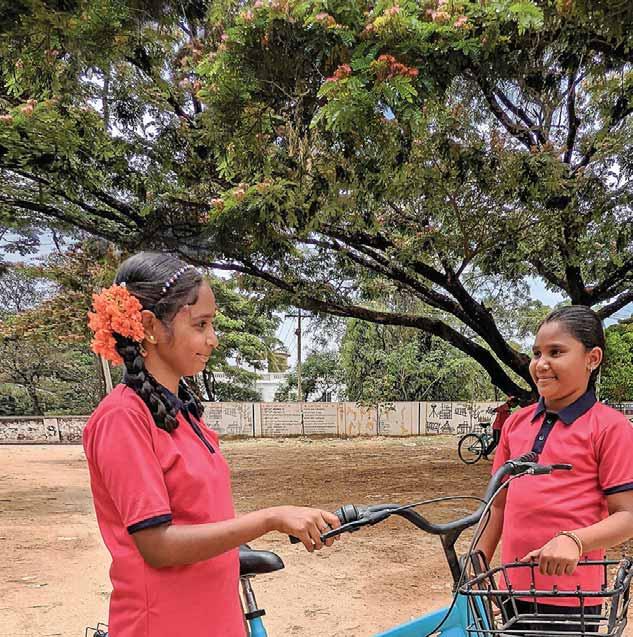
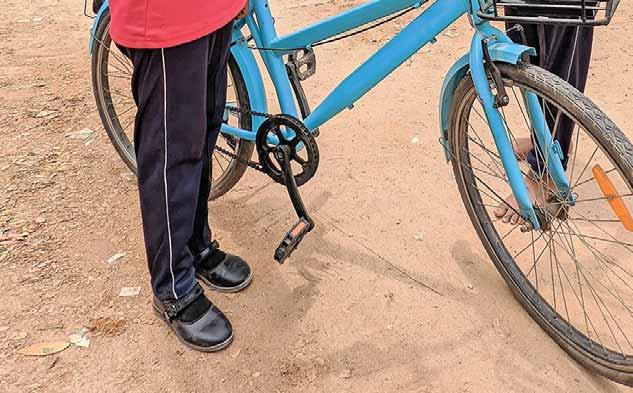






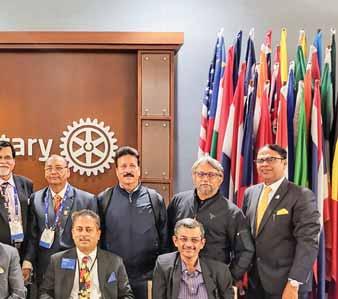
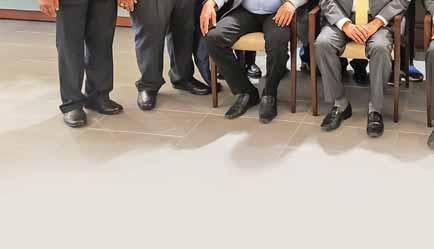
Seated, from L: RI Director AS Venkatesh, RI President Shekhar Mehta, RI Director Mahesh Kotbagi and TRF Trustee-elect Bharat Pandya. Standing, from L: PDGs HL Ravi (RID 3182), TVR Murti (3150), Subhash Sahu (3261), K Ramalinga Reddy (3160), Sudhir Mangla (3011), Ravi N Deshpande (3170), Prem Kumar Aggarwal (3090), Jitendra Dhingra (3080), TK Ruby (3080) and Sanjay Khemka (3250).
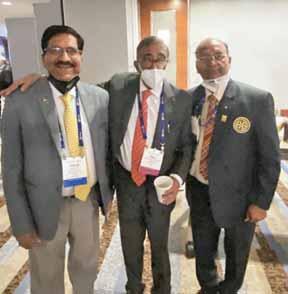
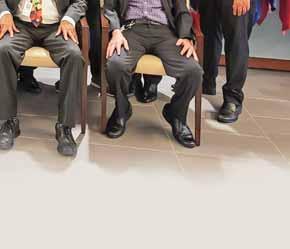

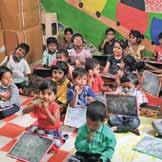

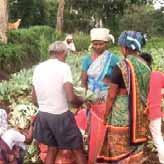
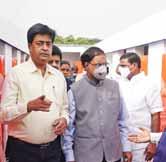
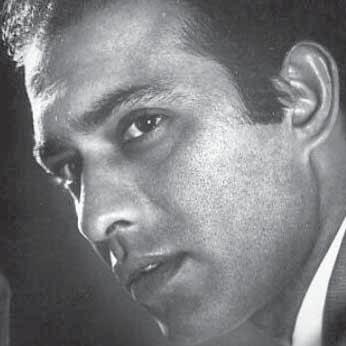

12
A single club in Bengaluru does 200 projects this year, spending over `1.5 crore
RC Bangalore Lakeside is the lead club in numerous large projects of RI District 3190.
24 A PDG’s passionate foray into sanitary pad and incinerator manufacture
PDG Vijay Rathi’s hard work has helped women in Latur enjoy better menstrual hygiene.
38 Rotaractors strengthen bonds over ROTASIA
Rotaract clubs of South Asia celebrated a mega international convention in Chennai with the participation of four countries.
40 A smart water solution for Karnataka’s farmers
RC Belgaum has installed a solar-powered smart irrigation model to help farmers in an electricity-starved village.
48 RC Madras, UK clubs construct toilet blocks in a school
A global grant facilitates two toilet blocks for students and faculty at a government school in the city suburb.
54 A trailblazer blind school in Solapur
The Bhairuratan Damani Blind School, run by RC Solapur also sponsors their college education.
60 Talat – a unique voice with tremor, tadap & tenderness
Talat Mahmood has enthralled generations of music lovers through his soft and mellow voice for decades.
68 How much carbon on your plate?
Read in the Go Green column about food choices that are environment-friendly and how to consciously reduce the carbon footprint in what you consume.

On the cover: Girls with bicycles gifted to them by RC Bangalore Lakeside under the district project Girls on Wheels.

As an inquisitive Rotarian, a voracious reader, and a part-time accredited scribe, I was attracted to your bold and precise writing in the Editor’s note — Ukraine’s pain… and media bias. As I’ve visited Ukraine in 2014 and 2019 and my son is settled there, I can gauge the pain and suffering of the people. You have nicely narrated the tale of World War II, its impact on world peace, and about the wars in Syria, Yemen and Afghanistan. Your concluding remarks are worth re-reading and commendable — A human life is a human life. That’s non-negotiable.
Abhay Kishore Sandwar, RC Dhanbad Midtown — D 3250
The April issue is yet another example of the wonderful humanitarian deeds by Rotarians across the country. Hats off to the Editorial team for bringing out exemplary issues. RI President’s message has focused on protecting nature, the Editor has nicely highlighted the media bias and carnage in Ukraine, and Rotary’s efforts to bring peace in this world.
The article on Pune Rotarians gifting a home for homeless children brings joy and pride in all of us. The devastation in Ukraine will make even a strong mind weep. PRID Kamal Sanghvi helped to rescue the children of many Rotarians from the war-torn land. Honouring 500 Rotarians completing 25 years in Rotary is a wonderful gesture. Setting up 100 dialysis units in Chennai hospitals will really ignite Rotary’s brand.
Rotary News has become a friend and guide to all those willing

to do more and serve more. Special appreciation to the editorial team for constantly improving the magazine’s quality.
Dr Jayasekharan VP RC Payyanur D 3204
It’s good that TRF has made provisions to assist victims of Ukrainian war. Really sad to read the pathetic condition of Ukrainian citizens as described by the Editor and pray for peace in that country. The assistance rendered by Rotary clubs to Ukraine is really commendable.
The cover photo of Renutai and the children is beautiful. Happy to note that Pune Rotarians have gifted a home for homeless children. The picture of a peacock sitting on a leafless tree is marvellous. RI President Mehta has stressed on the importance of protecting the Earth; the Editor’s note explains graphically the devastating perils of war and the bias in media reporting. RID Mahesh Kotbagi explains the importance of following rules in Rotary. RID AS Venkatesh
focuses on cordial relationship among Rotarians to retain membership. Other notable articles are Rotary brings to life a lost river; 500 Rotarians honoured for completing 25 years in Rotary; 100 dialysis units installed in Chennai hospitals; Bharuch Rotarians rescue kite-hit birds; and Rotary gives e-bikes for Bengaluru PHC workers.
Philip Mulappone MT RC Trivandrum — D 3211
I look forward to every issue of Rotary News as it brings me all the vibrancy and action of Rotary clubs across the country. RI Director Mahesh Kotbagi, TRF Trustee Chair John Germ and Trustee Gulam Vahanvaty’s messages were inspirational. The pictures of devastated Ukraine and the article pained me a lot. The work done by Rotary for Ukraine and PRID Kamal Sanghvi’s help in rescuing students from Ukraine are commendable. The cover story of a home for homeless children and report on 500 Rotarians being honoured in Pune were good. I was happy to see my club, RC Deonar doing great work in MHM under Project RED.
The cover page in the March issue showcasing Rotary’s polio work in Pakistan is timely. The rich tribute to Lata Mangeshkar is heartwarming.
RCCs have always connected with me and my club has done incredible work over the last 25 years in this area. Reading about RCC Vidyaranyapura was awesome.
Vivek Khandelwal RC Deonar — D 3141
I congratulate Team Rotary News for publishing another brilliant issue, full of information with balanced coverage of diverse subjects. My request is to add more pages to the Club Hop column.
Chinmaya Mahapatra RC Rajdhani Bhubaneswar — D 3262
The children were thrilled to read the article Annets on a water conservation drive. Thank you for featuring this project as it will encourage them to do more.
Senith Mathews, RC Madras Midcity — D 3232
RI President Mehta’s message on empowering girls gives clubs a signal to innovate new projects. Editor’s note on Lata Mangeshkar was superb. Pakistan crossing a year without a single wild polio case is good news to all Rotations involved in polio eradication efforts. The artificial limb fitment camp by RC Mumbai in association with the Ratna Nidhi Charitable Trust and RC Dharamshala is great work. Kudos to RC Madras for donating medical equipment to a
government hospital in Chennai. It is good that RC Nagpur Metro has started free medical consultation for senior citizens. Gifting a Paul Harris bust to Rotary clubs with their own building is an excellent way to respect Rotary’s founder. Congrats to PDG Bagh Singh Pannu, RID 3090, and the project coordinator Narinder Barwal from RC Hubli. Rotary clubs in Kerala want to install Paul Harris busts in their own buildings; this news will help them.
Daniel Chittilappilly
RC Kaloor — D 3201
RID Kotbagi has rightly pointed out that Rotary bylaws and policies are not used adequately. Rotarians have to be educated about these. I wonder how effective is the training of new members. RI must ensure that all members, especially club leaders, become wellversed in its bylaws, to ensure faster growth. After all, these policies are being formulated by many seasoned Rotarians burning midnight oil.
VV Narayanan
RC Chennai
KK Nagar — D 3232
The colourful feature on Lata Mangeshkar is well appreciated. I feel the content often gets limited to stalwarts from Chennai or South India, and many other events and facets get missed. Her photo on the cover page would have been most appropriate, as apart from her illustrious career, she was the recipient of Bharat Ratna. This would have been an honour to Rotary.
The cover pertaining to polio vaccination in Pakistan was in no way more important than Lata didi , but I can understand the Editor’s personal choice of Nishan-e-Pakistan over Bharat Ratna for the cover page. Again appreciate due space to Lata Mangeshkar in magazine.
Shirish Mandsorwale
RC Pune Kothrud — D 3131
For a Rotarian to cast a communal slur is most unbecoming, as Rotary’s credo is to rise above religion, class or community. It is another matter that as editor, my editorial decision is final, not requiring me to engage with you on how gravely important it is for Rotary to rid the world of polio. By the way, Dilip Kumar got Nishan-e-Imtiaz. Incidentally, Morarji Desai, the first non-Congress Prime Minister of India, was also awarded in 1990 Pakistan’s highest civilian honour, the Nishan-e-Pakistan, as it was called then. He was conferred the Bharat Ratna only in 1991! — Editor.
I found the April issue very interesting, especially the books columns on Bangladesh’s liberation and the writings of Afghan women. Both made for excellent reading, for which I congratulate you. If the government of India could
be outsourced to organisations like Rotary, it would make for a better India and world! Despite paying such high taxes we get nothing in return but pollution and frustration.
Mudit Jain RC Bombay — D 3141
We welcome your feedback.Write to the Editor: rotarynews@rosaonline.org; rushbhagat@gmail.com. Mail your project details,along with hi-res photos, to rotarynewsmagazine@gmail.com.
Messages on your club/district projects, information and links on zoom meetings/webinar should be sent only by e-mail to the Editor at rushbhagat@gmail.com or rotarynewsmagazine@gmail.com. WHATSAPP MESSAGES WILL NOT BE ENTERTAINED.
Click on Rotary News Plus on our website www.rotarynewsonline.org to readabout more Rotary projects.
Greetings, dear changemakers of Rotary,
Due to your positive response to the Each One, Bring One initiative, I am so happy to see that the membership trends in Rotary are looking up. Let us not lose this momentum — keep inviting new members, and also work hard to retain every member we attract. I look forward to seeing you next month in Houston at the 2022 Rotary International Convention, which I assure you will be a great event.

Also in Houston this June, we will be hosting my final presidential conference. We have devoted this year to conferences built around Rotary’s areas of focus. They have been a tremendous success, both in terms of attendance and in the ideas that were generated.
Last fall, our conference in the Philippines, which focused on protecting the environment and growing local economies, attracted 2,200 people online. In Brazil, our meeting centred around water, sanitation and hygiene, and how it relates to disease prevention and treatment; more than 600 people attended. That was followed by an event about the environment, economy and peace in Maputo, Mozambique, which attracted around 400 in-person attendees and another 700 virtually. Our conference about keeping the economy and environment
in harmony, held in Venice, Italy, had more than 600 in attendance.
Through these conferences and my world travels, numerous leaders have met with me and agreed to collaborate with Rotary. They include the prime minister of Mauritius, the president of Seychelles, the deputy prime minister of Bahrain, and the presidents of Albania and Kosovo. Clearly, Rotary is making an impact, and the world is eager for our leadership.
In Houston, the final presidential conference, Serve to Bring Peace, will focus on an area in which Rotary has long provided leadership. Everything we do in Rotary helps create the conditions that foster peace in communities, nations and ourselves.
In March, I was able to see firsthand the tremendous difference Rotary is making in Ukraine, as refugees continue to pour into Poland. Donors have contributed millions of dollars to this effort; our projects are making a tremendous difference, and there is enormous gratitude for your continued generosity and support.

Cameroon. And major refugee crises continue in Syria and Venezuela.
Rotary will always be on the side of the peaceful resolution of conflict and providing aid and comfort to people in need. Rotary was there at the end of World War II, promoting the creation of the United Nations and standing up for the cause of peacebuilding worldwide. It is time to renew our mission and perform our role as one of the world’s great promoters of peace.

There is no better way to Serve to Change Lives than to serve the cause of peace.

It is heartbreaking to see up close all the lives that have been uprooted, and the Ukrainian people are not alone. A devastating civil war in Yemen continues. The humanitarian crisis in Afghanistan is deepening. Armed conflicts affect nations across Africa, including Libya, South Sudan, the Central African Republic, northern Mozambique, Ethiopia and


Shekhar Mehta President, Rotary International
Sh President hekhar Mehta , Rotary Internatiional





hile the brutal attacks on Ukraine have been hogging media headlines, and rightly so, the unprecedented crisis in the tiny island country of Sri Lanka, with which we have such close ties, has failed to attract the world’s attention. Power cuts and blackouts for 15 hours, long, long queues for fuel, rising unemployment and a horrendous economic crisis, the worst in its history since its Independence in 1948, in that tiny, beautiful country, is really heartbreaking. So many of us have travelled several times to Sri Lanka, which had recovered so well from decades of ethnic strife and brutal militant activity that had turned Colombo’s prime roads akin to fortified war zones, complete with sandbagged roadblocks, and gun-wielding security personnel peering into cars, demanding to see your IDs. But after militancy was crushed, and the country limped back to normalcy and the tourists, specially the high-spending ones from the US and Europe, returned, Sri Lanka started thriving. Its pristine beaches, tropical climate and luxury hotels and resorts, and above all, polite and courteous people, were a big draw.
But then the Covid pandemic struck, sinking our entire world into a dark hell of disease and death, despair and desperation, locking up millions across the continents into their homes. As most businesses struggled to survive, the one industry that was devastated was the travel, tourism and hospitality industry. For almost 18 months, only a fraction of travellers ventured out into airports. One of the worst hit economies was that of Sri Lanka. Add to these Covid-related woes, including a crash in remittances of Sri Lankans working overseas, and the attacks on Ukraine sending fuel prices of petroleum products
skyhigh, the tiny island nation’s economic woes soared. The administration’s abject failure to take swift remedial measures has taken a majority of Sri Lankans to levels of dismay never seen before.
As a massive civilian uprising against the present leadership gathers force, the situation on the ground is grim. There is negligible foreign exchange left to import fuel or life-saving drugs; people are starving and deaths have been reported from the long queues for fuel. Our tiny neighbour needs more than our prayers; India has definitely helped out, but surely, we can do more. Luckily the country is so small, that any dose of financial or any type of succour injected into it will make a difference. I have seen for myself the passion that Rotarians in Sri Lanka put into Rotary’s central mantra — Service Above Self. Some great community service projects done by Colombo’s Rotarians have been reported in these columns. It will be interesting to see what steps Rotary International, and its passionate members committed to humanitarian goals, take to lessen Sri Lanka’s pain.
You’ll read in this issue how one small club in Bengaluru, yes, just one single club, RC Bangalore Lakeside, has done over 200 community welfare projects this Rotary year, with three more months remaining. That is almost one service project every day of the year! This is the strength you have… belonging to an organisation which can inspire the president of just one club — and we have nearly 4,400 Rotary clubs in India alone — to help thousands of people in his community. Imagine the muscle power of 4,000-plus clubs. Governments do their bit, but when people open out their hearts and minds, that’s when magic and miracles happen.
Rasheeda Bhagat
RID 2981
RID 2982
RID 3000
RID 3011
RID 3012
RID 3020
RID 3030
RID 3040
RID 3053
RID 3054
RID 3060
RID 3070
RID 3080
RID 3090
RID 3100
RID 3110
RID 3120
RID 3131
RID 3132
RID 3141
RID 3142
RID 3150
RID 3160
RID 3170
RID 3181
RID 3182
RID 3190
RID 3201
RID 3203
RID 3204
RID 3211
RID 3212
RID 3231
RID 3232
RID 3240
RID 3250
RID 3261
RID 3262
RID 3291
S Balaji
K Sundharalingam
R Jeyakkan
Anup Mittal
Ashok Aggarwal
Rama Rao M
Ramesh Vishwanath Meher
Col Mahendra Mishra
Sanjay Malviya
Ashok K Mangal
Santosh Pradhan
Dr Upinder Singh Ghai
Ajay Madan
Parveen Jindal
Rajiv Singhal
Mukesh Singhal
Samar Raj Garg
Pankaj Arun Shah
Dr Omprakash B Motipawale
Rajendra Agarwal
Dr Mayuresh Warke
K Prabhakar
Thirupathi Naidu V
Gaurishkumar Manohar Dhond
A R Ravindra Bhat
Ramachandra Murthy M G
Fazal Mahmood
Rajasekhar Srinivasan
Shanmugasundaram K
Dr Rajesh Subash
Srinivasan K
Jacintha Dharma
Nirmal Raghavan W M
Sridhar J
Dr Mohan Shyam Konwar
Pratim Banerjee
Sunil Phatak
Santanu Kumar Pani
Prabir Chatterjee
Printed by PT Prabhakar at Rasi Graphics Pvt Ltd, 40, Peters Road, Royapettah, Chennai - 600 014, India, and published by PT Prabhakar on behalf of Rotary News Trust from Dugar Towers, 3rd Flr, 34, Marshalls Road, Egmore, Chennai 600 008.
Editor: Rasheeda Bhagat.
The views expressed by contributors are not necessarily those of the Editor or Trustees of Rotary News Trust (RNT) or RotaryInternational(RI).Noliabilitycanbe accepted for any loss arising from editorial or advertisement content. Contributions — original content — are welcome but the Editor reserves the right to edit for clarity or length. Content can be reproduced with permission and attributed to RNT.
eople and nations disagree often, and disagreements may lead to quarrels. It begins with protest, warning, trying to stop the belligerence in a civilised manner and only when all fails, force is normally resorted to. The reasons behind the ongoing war in Ukraine are complex, and they can’t be seen as just black and white, because there are so many shades of gray in between.
From 1985 (when Mikhail Gorbachev came to power in the then Soviet Union) until 2008, at the Bucharest Summit, when the NATO led by US welcomed Ukraine and Georgia’s aspirations to join NATO, the West cannot name any major action that Russia has undertaken to threaten this alliance. This begs the question: Then why does NATO want to bring missiles and offensive weapons right up to Russia’s doorstep?
War is never good, but in all fairness, the world needs to look at all the dimensions of a war being waged to counter an existential threat. No war can be without casualties; truth being the first casualty. Civilians, homes, factories, etc, are bound to be destroyed in any war.
History tells us how during World War II, so many nations formed groups or an alliance to take on, and
defeat, Hitler’s Nazi Germany. It also tells us how, in the following decades, and till most recently, superpowers attacked smaller nations just to protect their own business, financial, military, political and other interests. And the world remained mostly silent.
What is the nature of the conflict taking place between Russia on one side and the combined forces of Ukraine-EU-America on the other side? There are three wars taking place simultaneously — the media war, financial war and war on the ground.
Rotary International stands with the UN General Assembly and human rights organisations in expressing grave concern at the deteriorating humanitarian situation in Ukraine. As a global humanitarian organisation, Rotary takes a proactive stance toward peacemaking by addressing the underlying causes of conflicts. This aligns with Rotary’s deep commitment to promoting peace through dialogue and conflict resolution. We are working with our international partners to provide relief and resources to more than 10 million Ukrainian refugees forced to flee the warzone. Our organisation is, as it should be, non-political and is always focused on service, just as the Red Cross and similar organisations.




Are we ready for the new Rotary year?
Planning is the key to success. It is very important for us to think in advance on what is to be done, where is it to be done, how and by whom it should be done. In simple words, planning is the bridge between our thoughts and execution. Another important factor of planning is time. Plans should be developed within a fixed time as you cannot go on just planning endlessly. So, planning and setting your club goals should get completed by this month. Do remember that planning is a never-ending process because changed circumstances may necessitate some course correction. Adaptability is the key to success in the current dynamic environment.

Shekhar Mehta RID 3291
Dr Mahesh KotbagiRID 3131
AS VenkateshRID 3232
Gulam A VahanvatyRID 3141
Rajendra K SabooRID 3080

you participate in the district training assembly, usually held between April and June.
I hope all the clubs have their teams ready for the upcoming year, have set the club goals, planned some key projects and are ready for some wonderful fellowship and friendship.
In the Rotary Learning Center’s Club Leadership catalogue, you’ll find courses that outline what you’ll need to know to succeed in various club roles. These learning plans are designed to be completed before
After all the planning, remember to enjoy Rotary even if all your goals are not achieved. What is important in Rotary is to love and enjoy every bit of your contribution to this world and cherish every friend you make!
I wish all my fellow Rotarians happy planning and best wishes for its successful execution!

Kalyan BanerjeeRID 3060
Panduranga Setty RID 3190
Ashok Mahajan RID 3141
P T Prabhakar RID 3232
Dr Manoj D DesaiRID 3060
C BaskerRID 3000
Dr Bharat PandyaRID 3141
Kamal SanghviRID 3250
Executive Committee Members (2021–22)
Gaurish DhondRID 3170
Anup Mittal RID 3011
Ramesh MeherRID 3030
V Thirupathi Naidu RID 3160
Jacintha Dharma RID 3212
Editor Rasheeda Bhagat
Deputy Editor
Jaishree Padmanabhan
Administration and Advertisement Manager Vishwanathan K
Rotary News Trust 3rd Floor, Dugar Towers, 34 Marshalls Road, Egmore Chennai 600 008, India. Phone: 044 42145666
rotarynews@rosaonline.org www.rotarynewsonline.org
Now share articles from rotarynewsonline.org on WhatsApp.

Asan engineer, I have worked my entire life for success that can be measured. I believe in the kind of success you can reach out and touch. And I also know that it doesn’t come overnight, it happens one step at a time.
At The Rotary Foundation, we don’t settle for a vague idea of doing good; we take measurable steps, ones that are concrete and real, toward a defined goal. It’s progress that you can see and tell your family and friends about, each step of the way.
Measurable success is what our new Programs of Scale grants are all about. The first member-led programme to receive this annual $2 million grant, Partners for a Malaria-Free Zambia (PMFZ), seeks to reduce malaria by 90 per cent in 10 highly affected districts within two provinces of Zambia. It’s an ambitious but achievable goal, based on a community health worker model that has been successful in reducing malaria in other parts of Zambia, as implemented by Rotary members and our partners on the ground.
To help end malaria in Zambia, The Rotary Foundation, World Vision US and the Bill & Melinda Gates Foundation are each contributing $2 million to PMFZ, whose Rotary-led programme already has begun to expand life-saving malaria diagnosis and treatment to hundreds of rural communities. So far this Rotary year, PMFZ has trained, equipped, and deployed more than 1,300 of the 2,500 new community health workers who will help local health centres reach more people who are vulnerable to malaria, such as mothers and children. PMFZ is also collecting and analysing data to ensure medical supplies get to where they are needed most. This work, along with the close collaboration between implementing partners and Rotary and Rotaract clubs across Zambia, has comprised the first bold steps toward our goal.
PolioPlus is another example of a global project that has been engineered for impact. The fact that we have reduced polio cases by 99.9 per cent worldwide is a testament to your generous contributions, our strong partnerships through the Global Polio Eradication Initiative, and a vast network of volunteers who administer drops to children around the world.
And we won’t stop now. Rotary spearheaded the drive to end polio, and Rotary will complete it. Encourage your district leaders to designate leftover District Designated Funds (DDF) for polio eradication, so we can finish the job. As an engineer, I have been proud to see my blueprints transformed into great structures and facilities. But perhaps I am even prouder of how together in Rotary we have engineered a better world — measurably, step by step, project by project. In Rotary, we can all be engineers of hope, building a better future for the next generation.
John F Germ Foundation Trustee Chair

Beforethe Rotary International Convention, leaders of Rotary Action Groups will gather for an open house to share experiences and search for collaborative opportunities. The event, called RAGTime, will take place June 2 at Houston’s Downtown Aquarium, a six-acre entertainment and dining complex that is home to more than 300 species of aquatic animals.
Rotary Action Groups are independent, global, Rotary-affiliated groups that are made up of experts in a particular field, such as economic development, peace, addiction prevention, the environment, or water. Action groups offer their technical expertise and support as clubs plan and implement projects. They can help clubs and districts find partners and funding, prepare grant applications, conduct community assessments, and develop plans to monitor and evaluate their projects.
At the open house, you can meet representatives of most of the 27 action groups, including the two newest: the Rotary Action Group for Menstrual Health and Hygiene and the Rotary Action Group for Refugees, Forced Displacement and Migration, both of which were established in 2020–21. The evening will include heavy appetisers and light music. To learn more about the event and buy tickets to attend, visit dna-rag.com/ rotary-in-action/ragtime-2022.
During the convention itself, June 4–8, attendees can find another type of international group led by Rotary members. Many Rotary Fellowships, whose members share a common interest or passion, will have their own booths at the House of Friendship, inside the George R Brown Convention Center.
Learn more and register at convention.rotary.org.




THE BEST WAY TO CRUISE is on the rivers with Uniworld
One-of-a-kind award-winning ships | The most all-inclusive amenities Outstanding service | Highest standards onboard & onshore

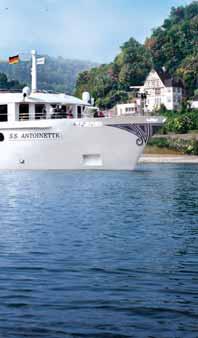


Set sail onboard one of Uniworld’s fl oating boutique hotels, each with a unique design inspired by the destinations they sail, to experience an immersive luxury vacation unlike any other. Enjoy visiting a variety of destinations in one trip, expert local guides, unmatched all-inclusive amenities and the best service in the industry.

CASTLES ALONG THE RHINE
8 Days | Basel to Amsterdam River Queen,S.S. Antoinette, or River Empress

SPLENDORS OF EGYPT AND THE NILE
12 Days | Cairo to Cairo
S.S. Sphinx

PARIS & NORMANDY
8 Days | Paris to Paris
S.S. Joie de Vivre

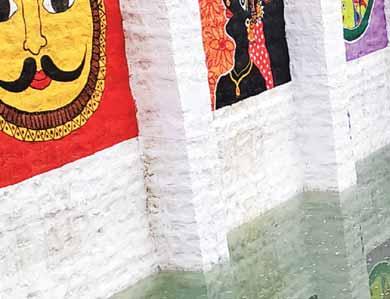

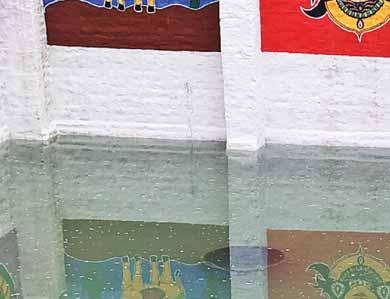

A single club in Bengaluru does 200 projects this year, spending over `1.5 crore
Rasheeda Bhagat
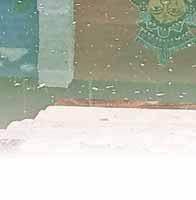

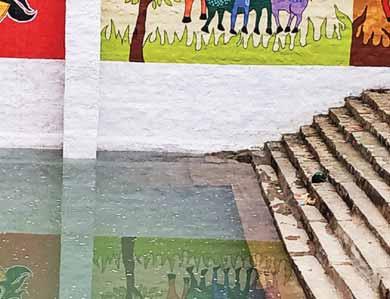
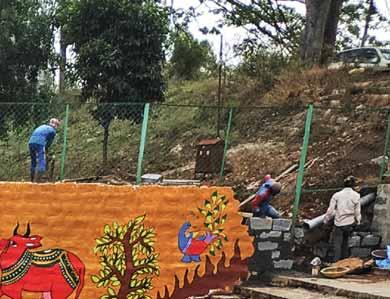


Asingle club in Bengaluru, RC Bangalore Lakeside (RCBL), has been carrying out projects at a breathtaking speed, participating with full gusto as the lead club in many of the larger projects of RI District 3190. “We’ve done about 200 community welfare projects this year alone,” says club president Kashinath Prabhu, nonchalantly. The cost exceeds a whopping `1.5 crore.
A beautified and rejuvenated Kalyani (a sweet water pond) at Anekal.
He has shared with Rotary News some details of 5–6 projects, each sent individually and if featured as such, would get at most a half or one-page display, or a mention in our Club Hop column. None of them carry any mention of the funds spent. But when I scan through the different mails, I’m struck by the sheer width and magnitude of the work done by this rather small club with only 55 members.

Above all, what is most striking is the partnerships this club has struck with both corporates and the voluntary sector, including small NGOs, as well as big names such as the Infosys Foundation and the Azim Premji Philanthropic Initiative (APPI).
When I congratulate Prabhu on the number of partnerships with so many corporates, he smiles, and says, “This is because all our basics are in place. We
have a trust with the required clearances and certificates, so it becomes easy for us to approach the corporates for a partnership. And when all the details are properly documented and accounts are clear, it becomes easy for their audit purposes and corporate norms. So the next year they come back, seeking further partnership. It’s a long process…”
For several years, this club, where the projects chosen are long-term and sustainable, has been scouting for service partners who are well-known in the community and have a solid track record. Prabhu himself is an IT
professional, and his club has made smart use of technology to raise funds. In some projects the club has resorted to crowdfunding and raised ` 5–10 lakh for each of these projects.
One of the club’s signature projects is sponsoring and supporting creches for the children of slumdwellers, migrant labourers, etc. Five years ago, the club forged a partnership with the Navajeevan Mahila Pragathi Kendra (NMPK), which was running seven creches for children from slums and
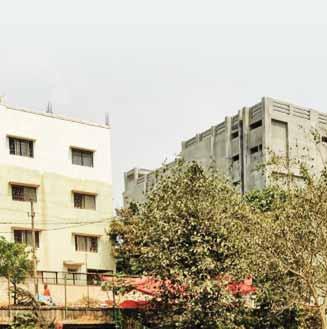


migrant labour families in Bengaluru. The club members started with small steps, partnering with the NMPK for activities such as donating food or sponsoring some events. Then it was decided that the next, or the eighth creche, would be “fully supported and financed by us. We raised about `10 to 12 lakh through crowdfunding which would suffice for expenses for two years, as each creche typically has about 50 children.”
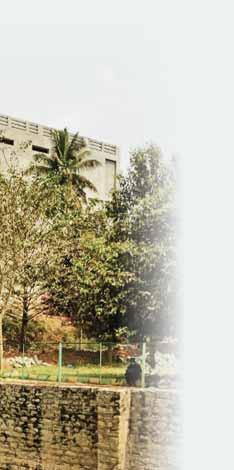
When this 8 th creche completed two years, its details were presented through a well-documented case study to the APPI. “When Azim Premji saw the details of this initiative, he was so impressed that he himself walked to the place to inspect it. He is such a simple person; we wanted to invite our members and have a big programme, but he wanted no fuss made at all. He loved the project and straightaway volunteered a long-term partnership,” says Prabhu. It is to the club’s credit that one of India’s most iconic philanthropists was so impressed by the way the Rotarians were running the creche that he immediately pledged `62 lakh for the next two creches — No 9 and 10. “On top of that he gave us additional funding to upgrade the existing ones. He said why don’t you take the existing creches to a bigger and better house, make them more hygienic and provide better facilities.” The 9th creche was supposed to be opened last year, but the whole project was delayed due to Covid. Premji had inspected the project just before the pandemic hit India.
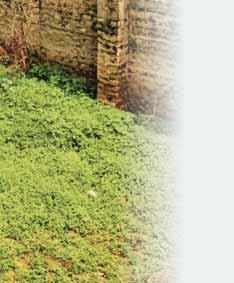
The 9 th creche, in association with the NMPK, the club’s partner, was inaugurated on March 1, on the occasion of Maha Shivratri, at Anandapuram, Jeevan Bima Nagar, Bengaluru. In these creches, apart from providing a nutritious breakfast and lunch, as well as an egg, basic literacy skills are imparted to the children in a safe and secure environment, through two teachers employed and paid by the club. The kids are children of maids
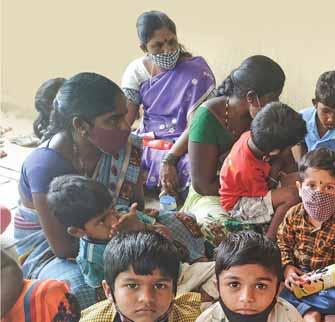



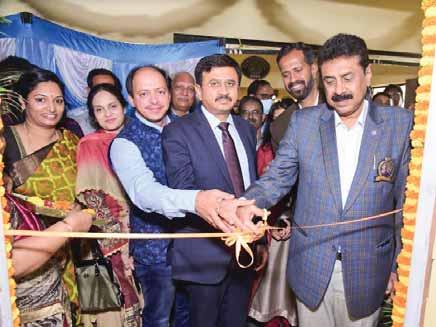
and other migrant workers, who leave their wards here in the morning and pick them up by 5pm. Counselling and training sessions are also offered to the parents, and festivals such as Diwali, Christmas etc, are celebrated here.
For both this club as well as RID 3190 this is a signature project; the district wants to do 100 creches in all, and for this ambitious district project, RC Bangalore Lakeside is the lead club. In another month, the club hopes to open the 10th creche, for which the APPI has given funding commitment. “To increase community participation, we provide an opportunity to the local people to sponsor a meal to celebrate a birthday or any other event. They can donate books or other articles,” says Prabhu.
But adequate funding is required to run or support such an ambitious

project in a mega city like Bengaluru; the yearly liability for each creche is around ` 5 to 6 lakh . “Our district clubs will have to get more CSR partners, donors and philanthropists and raise more money,” he adds.
Another ambitious and heartwarming project of both RID 3190 and this club is the project titled Girls on Wheels . This project, which fits
in nicely with RI President Shekhar Mehta’s focus on empowering girls, aims to provide bicycles to school girls in remote rural areas, so that at puberty they don’t drop out of schools for lack of safe or secure transportation to reach the school.
The larger district project aims to provide about 1,000 bicycles to girls in village schools who are in Class 6 or 7 in this Rotary year. Once again RCBL is the lead club for this project and to





begin with, the club, in collaboration with RCs Rajmahal Vilas and Bangalore Basavanagudi, has gifted 35 bicycles to schoolgirls in Koira village, about 80km from Bengaluru. The rural clubs in the district were asked by the DG to identify villages where girls in Class 6 or 7 face the threat of dropping out of school, for lack of safe transport. About `1.5 lakh was raised by the Rotarians and the bicycles have been given to the girls, bringing smiles, and
Children learn basic literacy skills at the creche set up by the club.






fulfilling the teenagers’ basic right to school education.
Once again, the club president says, “we will make a proper case study of this project and then take it to a corporate like Hero Cycles to explore the opportunity of a much larger partnership so that 1,000 girls can get this essential access to education.”
This young, dynamic and tech-savvy president has already completed 200
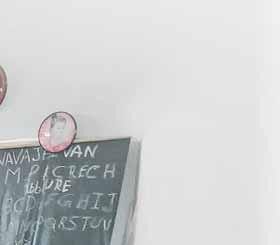

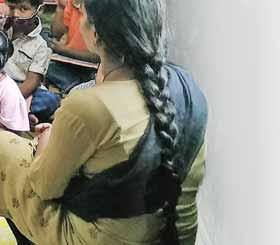

projects during his year, spending over `1.5 crore.
Even as Rotary celebrated its 117th birthday on Feb 23, the club, in collaboration with two CSR partners — Embitel and Corsair Gaming, formally launched two mobile medical units, under the project titled Sukh Sandhya, an initiative of RID 3190. This is being done with the support of Dream India Network (DIN) which is working in the area of providing critical medical care to senior citizens living in charitable old age homes and abandoned people.
While Embitel Technologies is driving digital transformation through advanced technology in various fields, Corsair Gaming is an American computer peripherals and hardware company headquartered in California. RCBL has been working with a couple of homes for senior citizens, from where there are periodic requests for bedsheets, blankets, etc. But stepping up this association, it has recently taken up the task of ramping up and upgrading two ambulances belonging to DIN, which takes care of the medical needs of the elderly as well as provides succour to people abandoned on the roads. About `7.5 lakh was spent on each ambulance.
When such cases are brought to the notice of DIN, which has a tie-up with a couple of hospitals, the abandoned person is picked up and taken to the hospital for initial medical treatment, if required. After basic treatment these people are taken to a nearby old age home and taken care of.

Under Sukh Sandhya, some 40–50 old age homes have been identified and different Rotary clubs will be invited to take up the challenge of making them “happy elderly homes”, by working in collaboration with DIN. The upgraded ambulances were recently inaugurated in the presence of DG Fazal Mahmood, PDG KS Nagendra and Edward Thomas from
When Azim Premji saw the details of this initiative, he was so impressed that he himself walked to the place to inspect it. He loved the project and straightaway volunteered a long-term partnership.
Kashinath Prabhu president, RC Bangalore Lakeside
DIN and members of RCBL. Both the ambulances, manned by both doctors and paramedics, will go to homes for the elderly to provide regular medical check-up to the inmates and give medicines where required.
Another project launched in March by RCBL, in association with Rotary Mulbagal Central, was the inauguration of a computer lab with 109 desktop computers at the Government Polytechnic College, Mulbagal. The club has sponsored a total number of 337 PCs to government institutions including the Institute of Textile Technology (33), GR Institute of Commercial Practice (62); Government Polytechnic College, Mulbagal (109); and the Government Polytechnic, KGF (133). This project is in partnership with the Infosys Foundation and the department of technical education, Karnataka government.
DG’s endorsement
Commenting on his dramatic performance, DG Mahmood says, “Prabhu
is really an outstanding president, he is very well connected, and does projects at an amazing speed, sometimes, he does even 2–3 projects a day!” Above all, says the DG, “his ability to get corporate partnerships is amazing. For instance, it is not easy to get collaboration from the APPI, because they do their own work, but he managed it! Apart from his skills in getting good partnerships, Prabhu excels at getting other clubs involved in the projects.”
And these, he adds, are not always prominent or bigger clubs; “he gets the smaller clubs and some clubs outside the city are also involved and this fits in very nicely with our district project Sahayoga (collaboration) which aims to get the clubs in Bengaluru to work along with the smaller clubs outside the city.” He explains that of the 162 clubs in RID 3190, only around 100 are in Bengaluru, and the other 62 are in smaller places, and Sahayoga aims to involve all these clubs in service projects.
Rejuvenation of a temple pond
On World Water Day, RCBL, in collaboration with RCs Bangalore Basavanagudi and Bangalore Spandana, inaugurated a beautified and rejuvenated Kalyani (a sweet water pond) at Anekal, a Bengaluru suburb. Each of the three clubs raised around ` 50,000, and with support from the panchayat leaders, municipality workers and the local community, which gave shramdaan , the derelict pond was cleaned and obstructions around it cleared so that freshwater can now flow in. A painting competition was held and the entire area surrounding the Kalyani has been decorated with colourful paintings. A Gange puja was held at the rejuvenated Kalyani, in the presence of community leaders, local organisations and citizens. It took about seven weeks of shramdaan
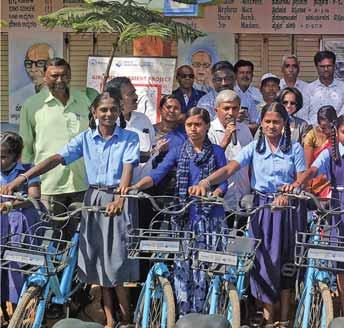



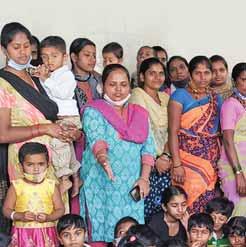
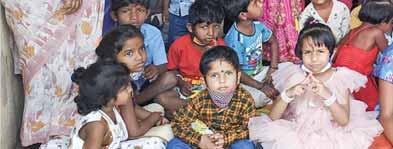



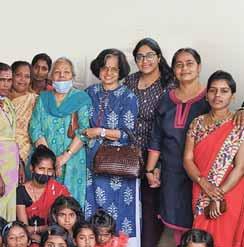
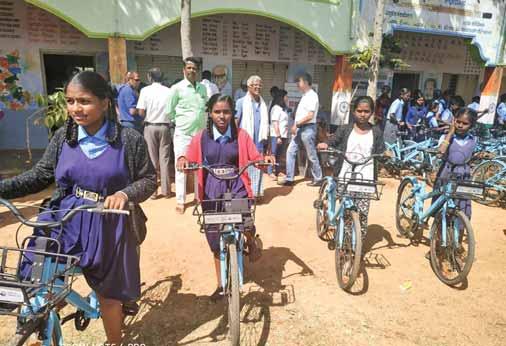
Left:
Below: Parents, children and staff with Rotarians at the creche.

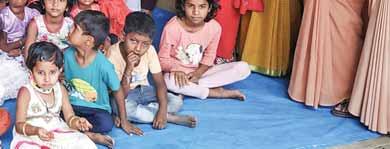

for volunteers to make the associated infrastructure and art work to rejuvenate the river. Rtn Gurunagesh, DLCC (district literacy committee chair), who hails from Anekal, took special initiative to get this project going.
Further work is required to ensure that the river remains free of obstructions and can get sweet water flowing into it. Hence a small committee of Rotarians and the locals has been formed to ensure there is ownership.
As he recounts other projects, including one done in collaboration with Rotary Bangalore Basaveshwaranagar, to renovate and modernise a kitchen at the Kidwai Hospital, which aims to provide free food (three meals a day) to over 500 attendants of patients every day, I joke with him about being a “fulltime Rotary president”, as it requires a colossal amount of work for a club president to implement 200 projects during his year, with three months still remaining. Prabhu laughs, and says, “Actually, the Covid pandemic gave me an opportunity, as I was working from home. And we also do Rotary work till late hours, and a lot of planning and coordination is done on the phone.”
Designed by N Krishnamurthy
During the Covid pandemic, a group of teenagers in Pune were eager to do their bit for the medical frontline staff, inspired by their Rotarian parents. “When we were busy collecting and distributing masks, PPE kits and sanitisers to frontline and sanitation staff through my club, RC Poona Downtown, my daughter and her friends kept badgering us that they too wanted to pitch in and do something. That’s when we formulated the idea for a
community-based Interact club,” says Aashima Agashe, youth director, RC Poona Downtown, RID 3131.
Soon children from across various schools came together and thus was born the Interact Club of Poona Downtown, “probably the first community-based Interact club of the district.” Presently it has 24 members, including two boys, from three schools — St Mary’s, Symbiosis and Gurukul. “We made it clear to them that the club has to stay and cannot
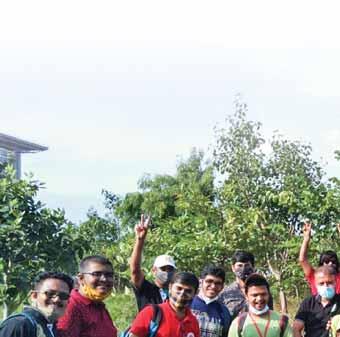
be abandoned after the Covid pandemic,” says Aashima.
The Interact club began its service journey with Project Green Period , the district’s signature project. The Interactors wanted to reach out to less privileged children of their age. They voted on various ideas and zeroed in on menstrual hygiene with an underlying focus on the environment. “We were excited with the idea
Interactors of Sundarji’s Stars, along with members of RC Poona Downtown, planting saplings at the Anandavan forest.
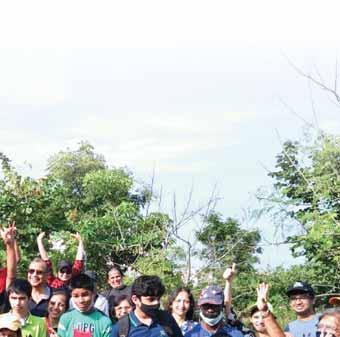

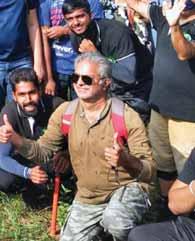

as we have been studying in school about how synthetic sanitary napkins and diapers are non-biodegradable and harmful for the environment,” says Ananya Agashe, the Interact club president.
The young members made a one-minute video clip talking about this project and circulated it among friends and neighbours on the social media. By the end of the campaign, they had collected ` 1 lakh. “It was heartening to see these children constantly planning and following it up,” says Aashima.
The next phase was to source the napkins. When Aashima suggested distributing cloth pads to adolescent girls as was done by the district Rotarians, many concerns were voiced. “The Interactors asked me, ‘if you are suggesting cloth napkins, they must be washed clean. Then what happens to water conservation? We from well-to-do families can dry the napkins in some private place. But what about the girls living

in slums? Where will they find a private place to dry them?’ So I had to come up with some other solutions.”
Compared to adults, with whom the girls are tonguetied and shy on menstrual hygiene topics, it was fascinating to see a free discussion between the two groups without any inhibitions.
Aashima Agashe Youth Director RC Poona Downtown RID 3131
After detailed research she identified 5–6 manufacturers who make biodegradable cloth napkins, and the Interactors chose a manufacturer in Navi Mumbai who makes 100 per cent biodegradable pads. Within 100 days the process of degradation starts when it is put into a compost pit and the used napkin can even be mixed with wet garbage if it is wrapped in newspaper.
The Interactors, accompanied by Aashima and a couple of Rotarians, visited a municipal school and promoted these sanitary napkins to the girls, interacting with them on the problems they face during their menstrual cycle.
Aashima says that compared to adults, with whom “the girls are tongue-tied and shy on such topics, it was fascinating to see a free discussion between the two groups without any inhibitions. For us it was a huge eye-opener.”
The Interactors gave the schoolchildren pads to last for six months and left with a promise to return. They want to scale up the project to include more such schools, says Ananya.
Another project was providing toys, sports equipment and indoor games to a day-care centre that takes care of 50–60 children of migratory workers. Three huge cartons of clothes and sports goods were collected and given to the centre.
“Our next project will be for an old age home,” she says, adding that the members have paused all activities for the next two months as they are busy with their exams, but will resume soon, as they meet regularly online.
Interact club for special children
Interact Club of Sundarji’s Stars is another special club sponsored by RC Poona Downtown last December. All the members are either mentally-challenged or have some developmental disorder such as ADHD, but they are not physically-challenged. “You see these children excelling in
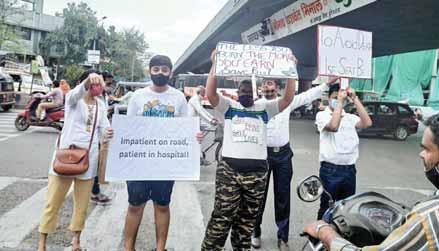
one skill or another. But they are not as comfortable as ordinary children in interacting with people in society. Some of them just clam up when they are taken away from their comfort settings,” says Aashima. The staff accompany them on their outings for projects.
Along with her team of Rotarians, she guided the Interactors for a traffic awareness campaign. “The staff in-charge Vinamrata explained the project to the children in the way they can understand.” The children made placards with slogans on road safety and the Rotarians and Vinamrata
accompanied them to a busy traffic junction. “At every red signal they would go to the centre of the road and hold up the placards. When they saw somebody with a helmet, mask or seatbelt on, they went up to them and gave a thumbs up, and a thumbs down for people who violated traffic rules. It was very endearing to watch them do that and it was a learning experience for the children too.”
The Interactors also carried out a cleaning activity in a municipal park. “We got them brooms, masks and large-sized garbage bags and they collected 7–8 bags of plastic waste.”
The Interactors planted saplings at the Anandavan Reserve Forest and visited Santulan Bhavan, a centre for children of migratory workers, to distribute clothes. With the help of their school’s physical trainer, they engaged the children in some fun fitness activity.
Askin check-up camp was organised by RC Chennai Bharathi, RID 3232, with the support of the National Leprosy Education Programme and the Gremaltes Hospital at an anganwadi in Puzhal on the city outskirts to mark World Leprosy Day and World Neglected Tropical Diseases Day. Rtn Dr Renuka Ramakrishnan, dermatologist and director, health services of the club, along with Dr Dharmalingam, deputy director, TN Medical Services, and Dr Marianathan, director, Gremaltes, screened the patients and distributed medicines.
Covid vaccination was also done at the venue. Around 200 patients
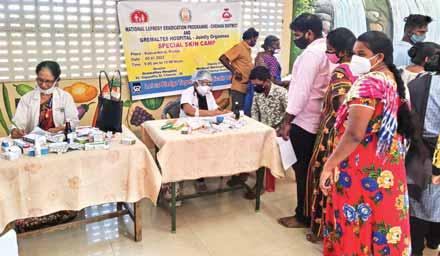
were screened for skin ailments, of which one person was identified with leprosy. Dr Renuka gave a special
talk on the disease in a webinar which had a participation of around 40 people.
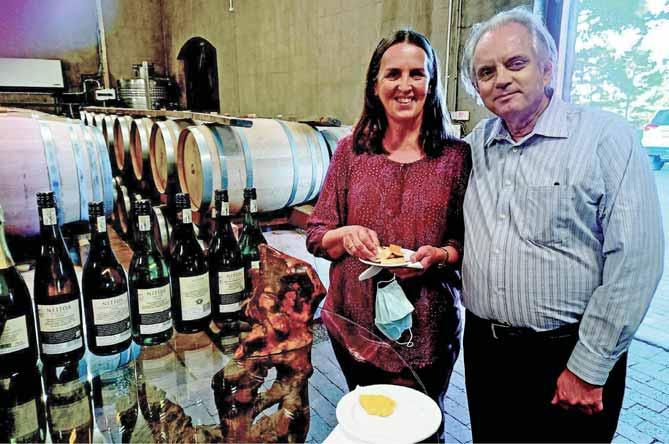
The Rotary E-clubs of Hamburg-Connect, Germany, and Greater Cape Town, South Africa, planned the perfect fundraiser around this perfect theme — with a bit of “shaken, not stirred” added. The end result was an online wine tasting fundraiser that served wine to change lives.
Members of Rotary clubs, NGOs, businesses, and their friends gathered from Germany, Namibia and South Africa to be part of the tasting experience. The guests tasted the exact same wines at the exact same time while listening to a winemaker. This took some careful planning, but it worked brilliantly.
Beautiful wine tasting boxes that included spices and tasting notes were
sent to help the guests become future expert wine drinkers. The winemaker walked them through the tasting process, which included smelling and tasting the spices before sipping the wine, and then comparing the senses and wine notes.
The tasting was not just virtual, as each of the virtual guests had invited a small group of people to join them at their home to share the tasting experience.
At the Nitida wine cellar in Durbanville, South Africa, spirits were raised by the guests who had been invited to enjoy an exclusive tasting and a meal prepared by the farm restaurant. Among these guests were District 9350 Governor Ian Robertson and his wife, Barbara, past district
governor Carl-Heinz Duisberg and his wife, Caroline, many Rotarians, and some potential new Rotarians.
During the tasting, a wonderful surprise was revealed when 2020–21 Rotary President Holger Knaack joined from Germany, shared a special message, and stayed to enjoy the whole evening.
About $2,600 was raised for an early childhood development centre in Temperance Town, Gordon’s Bay, South Africa, which is in dire need of upkeep and renovations. Members of the Rotaract Club of False Bay will be greatly involved with this project and add their skills to it.
Rasheeda Bhagat
About four years ago, when PDG Vijay Rathi, RI District 3132, was on one of his frequent visits to Latur in Maharashtra, he was curious about the observance of menstrual hygiene in its rural belt. “We own some farmland, and I was travelling with my daughter and granddaughter; it’s a delicate subject for a man to discuss with women, particularly in rural India, so I asked both of them to chat with the women and find out something about what the women, particularly adolescent girls in schools and colleges in that belt, use while menstruating.”
He was shocked to find that “even in today’s advanced age, many females were oblivious to the use of sanitary pads, and were using age-old
conventional things such as old cloth, actually rags, grass ash, wooden dust and sometimes even mitti (earth) during those difficult days.”
Interested in projects related to health, and a Rotarian for 52 years — he is a member of RC Latur Horizon — Rathi decided to do something to change this state of affairs. “I knew that the root causes of this unhygienic, and extremely dangerous practice, were poverty, ignorance, tradition and lack of knowledge of the health hazards that could result from such a practice,” he recalls, in an interview to Rotary News
As the passion to do something to help these women/girls possessed him, “I discussed with my joint family that I wanted to do a project to make

sanitary pads. As we have some family land, I proposed to them that we donate one hectare (2.5 acres) of our land in that area to set up a unit for making sanitary pads.”
Once the family came on board and the decision to donate the land — which is now worth `50 lakh — was
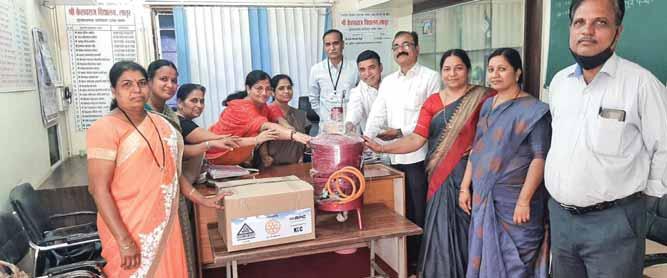

made, Rathi took the project proposal to the National Association for the Blind (NAB), where he is a member of the executive committee. The Board decided to grant some funds to construct a shed of 4,000 sqft to set up a unit to make sanitary pads on his land. Village women, and a few blind persons in the village, were trained to make the pads, and once the machinery and other infrastructure were in place, production of sanitary pads began.
Seven local persons have got employment in this unit, which has produced over 1.5 lakh pads till now. The pads have all been distributed free of cost to the needy. Members of RC Latur Horizon have got involved in the project and help in creating awareness about how crucial menstrual hygiene is for women’s health and well-being.
Manmohan Sarda, a former Rotarian, who has got involved in this project as a volunteer, says that once the
local Rotarians of Latur got involved in the project; “we gave them the pads free of cost, and the Rotarians motivated the women to use these pads, understand their health benefits, and slowly the acceptance of sanitary pads has started growing in the region.”
He left his club a few years ago “as it was not active and was hardly doing any projects.”
Once the sanitary pads production unit was in place, next came the question of disposal, because most often, used pads are either dropped in toilets which can choke the drainage system, or are thrown in dustbins or just out in the open, creating messy garbage and harming the environment.
Rathi explains that the conventional incinerators available in the market work on electricity and the areas where these machines needed to
be placed for proper disposal of the used pads had erratic power supply at best, with long hours of load shedding. His mind started working on ideas for alternative use of energy to work the incinerators; at first he thought of firewood, but then that would result in an ecological imbalance. “My son is an engineer and fabricator, and he runs a paper mill in Latur. Along with a couple of his colleagues he set about the task of making an incinerator that was user-friendly and had an energy source other than electricity.”
Not only was the power source a problem; the other tricky part was that the common incinerators used for the disposal of sanitary pads have “some six knobs, and even if one of them stops working, the machine will not work. They came out with a model that can work on firewood, LPG, and even agro waste, plenty of which is available in rural areas. The capacity of the

electrical unit is only about one-third of our unit, whereas its cost is five times higher! (This incinerator costs around ` 5,000). Even the guarantee or warranty of the former is limited, compared to our incinerator,” adds Rathi proudly.
Under this project, until now, 205 incinerators have been manufactured and distributed free of cost through Rotary clubs in RID 3132 to schools,
women’s organisations, NGOs, gram panchayats and others. On how the money was raised, he says, “When Suhas Vaidya was our DG, he was very impressed by this project and gave money from the district designated funds for 44 incinerators. Kishore Lulla, an AKS fellow and a member of RC Sangli (RID 3170), donated `1 lakh for this project, the RPG Foundation
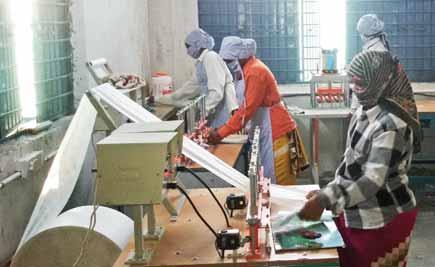
gave `7 lakh, and other organisations from Mumbai have donated too.”
Asked why they didn’t go for a global grant, the PDG smiles and says, “Of course we tried very hard to get a GG. We found a foreign partner and met all the requirements, but our grant was rejected, maybe on some technicality.”
But undeterred by this rejection, which came a while ago, the Rotarians have worked hard to raise the money and in Feb 2022, at an event, sanitary pads and incinerators were distributed to various organisations.
Education Commissioner of Maharashtra Vishal Solanki, RID 3132 DG Omprakash Motipawale, RPG Foundation and other donor organisations’ representatives, and zilla parishad officers and local citizens, along with Rotarians, participated. Rathi adds that they have already applied “for a patent for our incinerators, and are hopeful of getting it soon.”
Rotary clubs which wish to replicate this project can contact PDG Rathi at 9404273778.
RI Director Mahesh Kotbagi announced the setting up of the ‘Rotary Global Peace Park’ at Kartarpur in Narowal district, Pakistan. He, along with his wife Amita and Rotarians of RI District 3070, visited the Kartarpur Sahib gurudwara. They were given a warm reception by RIDE Faiz Kidwai, RID 3271, Pakistan, in the presence of over 350 Rotarians from districts 3271 and 3272.
The visit was made memorable with a provisional chartering of RC Chakwal (to be sponsored by RC Lahore Garrison), with 25 members in RI District 3272, Pakistan. The new club plans to execute joint projects on literacy and heart surgeries with Indian Rotary clubs.
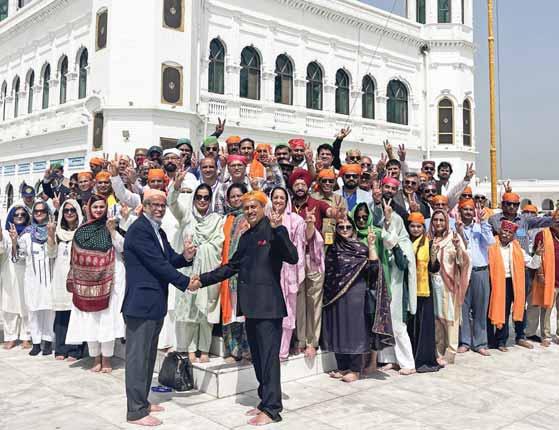
Foundation guidelines
Ways to contribute to Rotary Foundation (India)
Contributions from donors in India are received by Rotary Foundation (India) on behalf of The Rotary Foundation. Contributions can be made through cheque/bank draft and mailed to Rotary International South Asia Office. Online transfers can be done through www.rotary.org by using credit/debit card or net banking. All contributions to RF (I) are eligible for 50% deduction under section 80G of Income Tax Act, 1961.
TRF guidelines for re-classing contributions
Current year requests for re-classes will be accepted and processed provided they are received within 60 calendar days of the gift receipt date and within the same Rotary year. Requests for transactions involving prior year re-classing (correction) of contributions from any Rotary Foundation fund, project or programme to any other fund, project or
programme cannot be accepted and processed after the end of that fiscal year.
Individuals are recognised as Major Donors based on their personal contributions. Major Donor status cannot be bestowed on an individual based on support from other donors or a “matched” contribution, either in part or in full, by a district, other entity or corporate. If a contribution is made by a family-controlled company or a family trust, it may officially provide in writing that the actual credit be given to the owner or trustee of the trust.
Only contribution by a spouse can be linked to an individual’s Major Donor recognition. Merging of contribution from lineal descendants or ascendants (grandparents/ parents/siblings/children etc) do not count for Major Donor recognition.
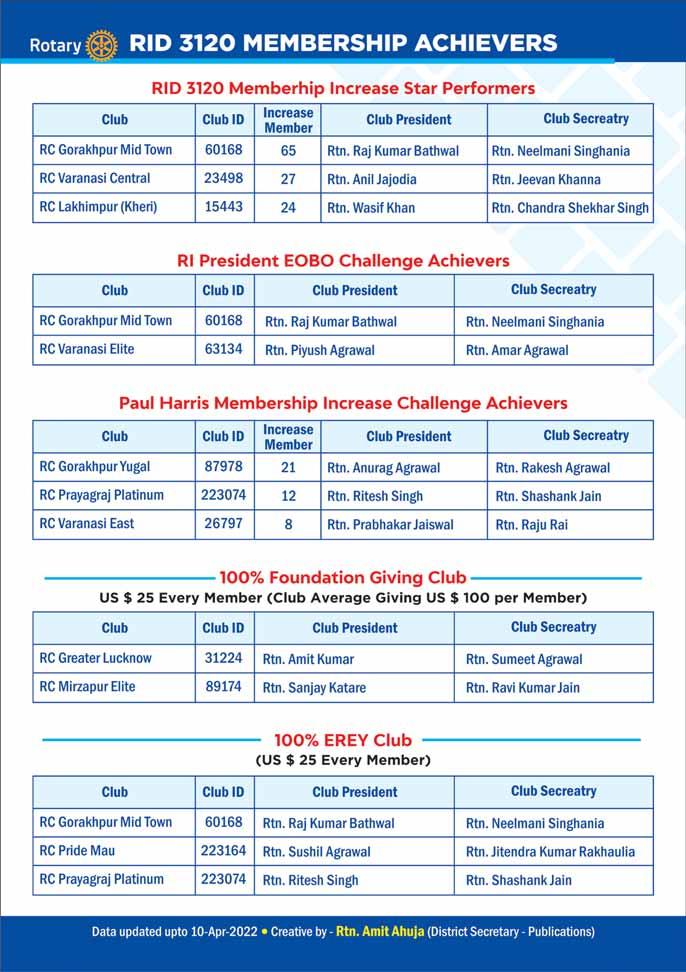

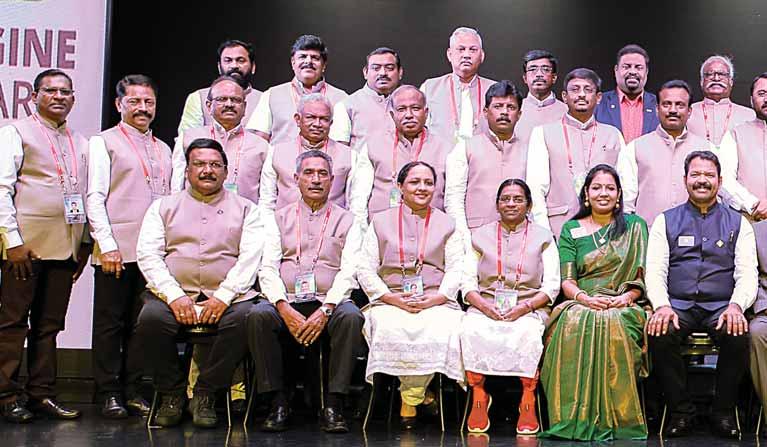

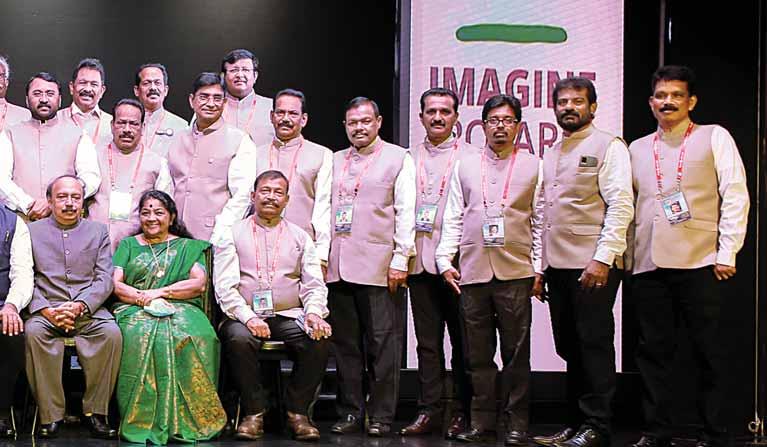
K Babumon (seated 4th from R) and his wife Beena with the incoming assistant governors.
The incoming governor of RID 3211, decided to celebrate the nearing end of the Covid pandemic and the 117th birthday of Rotary by conducting his AGTS (assistant governors training seminar) on board a cruise ship from Feb 23–26, and aptly titled it ‘Sagara Madhanam’. Cordelia, the luxury cruise ship, provided
the perfect setting for the group led by DG K Srinivasan, DGE K Babumon and his wife Beena, district trainer PDG KP Ramachandran Nair, PDGs, DGN Dr G Sumithran, DSGE Vijayalakshmi Nair, other district officers and the 36 assistant governors-elect of the district.
Apart from providing so much fun, laughter and of course learning, our AGTS also served to promote Rotary’s public image as there were about 1,000 people on board who came from all over India.
DGE K Babumon
As Rotary’s anniversary cake was brought by the ship’s crew to the festively decorated deck, with colourful streamers, festoons and balloons, as the ship sailed on the high seas between Kochi and Mumbai via Lakshadweep, the DG and DGE jointly cut the cake.
As the Rotarians sang in full-throated gusto ‘happy anniversary to Rotary’, the echo reverberated over the splashing waves of the Arabian Sea.
DGE Babumon said: “Apart from providing so much fun, laughter and of course learning, our AGTS also served to promote Rotary’s public image as there were about 1,000 people on board who came from all over India. In addition, there were some 600 crew members spread across the 10 decks.
Our celebration and camaraderie attracted their attention and many of them were asking questions about our organisation; what Rotary is and what kind of work it does. Many were more than curious. Some even enquired whether such an organisation was available in their particular towns, and a few even expressed the desire to join Rotary.”
The Rotary group was a big and merry one and over 360 people joined this cruise. When the ship reached Lakshadweep, while the AGEs remained on board for the training, their spouses and children went on shore to enjoy games and water sports.
When the cruise ended in Mumbai, the Rotarians and their family members enjoyed a day’s tour of the metro, and then took a flight back home to Kochi. “The incoming assistant governors had a satisfying and purposeful threeday training session, and were given certificates signed by RI Director AS Venkatesh,” added the DGE.
Kiran Zehra
Sinder Kaur is a little more fortunate than the rest of the women who come to learn phulkari (flower craft) embroidery at the Khera
Gajju village, near Patiala, where RI District 3090, in association with Madhav Stelco, has set up a vocational training centre for women who desperately need a source of

income. “My husband supports me and takes care of the children while I am here learning phulkari embroidery. I realised how privileged I am unlike many women from my
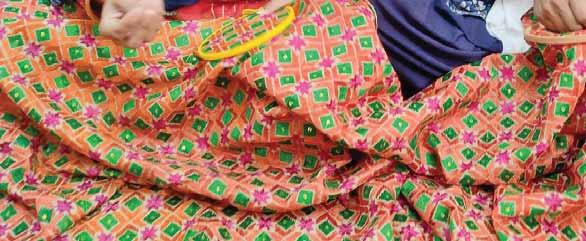

class who go through domestic violence and abuse,” says Sinder. Rajni, a domestic help, who has enrolled in the vocational training programme and earns “much less money than required to run my family” feels lucky too. Her husband is an alcoholic and she has two children to provide for and educate. After learning phulkari, she hopes to find a decent paying job in Patiala and move out of Khera Gajju. But for now, “Achha lagta hai (I feel good),” she says “to come to class and talk to all the ladies and to know that I am not alone. Running these colourful threads through the fabric creating beautiful patterns makes my stress go away,” she says.
The vocational centre was inaugurated by Meenu Goyal, director of Madhav Stelco, and DG Parveen Jindal in Feb 2022. The `1,50,000 CSR grant covers material, trainers’ fee and the cost of tailoring machines. Currently working with 30 women, the centre aims “not only to find these women placement as assistant designers but also to promote phulkari, the traditional Punjabi handicraft. Machine embroidered fabrics and garments, which are commercially produced are pushing phulkari out of business. Through the vocational programme we are not just creating awareness but equipping these women with
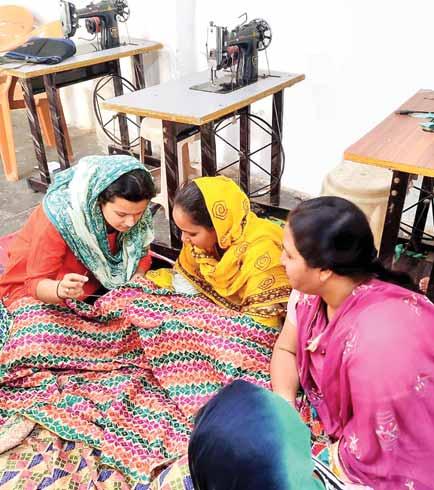
employable skills,” say AG Rajiv Goyal, the project chair.
Currently working with 30 women, the centre aims not only to find these women placement as assistant designers but also to promote phulkari, the traditional Punjabi handicraft.
No previous embroidery knowledge is required for this threemonth training programme, although the craft is slow with methodical hand exercise. “These women are quickly learning the embroidery and advancing at a steady pace,” says Rekha Maan, the trainer and mentor of the programme. She is a member of RC Patiala Royal and has won a national award for her phulkari designs. They want to finish the course soon “and gain financial freedom from their abusive husbands and improve their standard of living.” As part of the programme the women are also taught how to stitch and design dresses and salwar suits. “This will help them in creating an
entire outfit all by themselves which means they can earn more money,” she points out.
Rekha is working closely with these women to help them complete their first fabric assemblage and build self-confidence. “We are going to host an exhibition for them and hope their outfits get auctioned at good prices,” she says.
The district, in another separate CSR grant with Madhav Stelco, is training 26 girls in cosmetology. Books, stationery, make-up kits and other accessories are provided to the participants free of cost and they are given hands on training by professionals on skin and hair care. The total cost of the project so far has been `50,000, and it is supported by RC Faridkot.
Rajendra Saboo
Sometime back, my son and daughter-in-law celebrated their 40 th wedding anniversary. Amidst a cheerful atmosphere, their friends were having fun, joyfully clapping and
dancing to the rhythm of film music. They persisted, and hesitatingly we too started dancing, attracting appreciation from the youngsters. I recollected how dance came into our
lives. We were young when we started to learn ballroom dance while holidaying in Mussoorie with my sister and brother-in-law. All of us joined the dance classes and started taking lessons
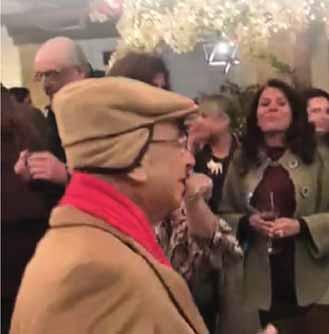


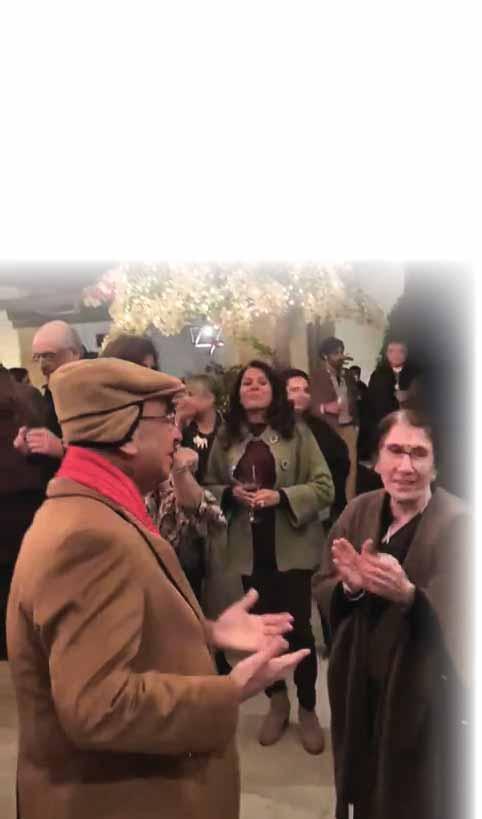
in foxtrot, waltz and cha-cha-cha. We were enthusiastic, but time was too short to learn much.
After returning to Chandigarh, we pursued our lessons and engaged a dance teacher whom we nicknamed ‘Mr Nacha Singh’. Our friends, Narendra and Indu Goswami, Lalit and Usha Suri, also joined us with gusto. As our professional work needed more time, slowly we gave up dancing.
Around 1963, I was invited by our German business partner, Willi Dowidat, for his daughter’s wedding. I participated in the ceremony which was held in a church. In the evening at the reception, all the important guests were supposed to dance with the bride, I being a privileged one. However, it was an acid test for me. As the queue for dancing with the bride was getting shorter, I was getting more nervous. I explained my predicament to someone, knowing the bride was wearing a long gown and I may step on her dress. He quietly shifted me from the line.
On another occasion, I was the incoming Rotary International president
at the International Assembly in the US.
President Paulo Costa and his wife Rita insisted that my wife Usha and I join them on the stage. I was to dance with Rita, Usha with Paulo. It was a great honour but we felt uneasy. They both being proficient in dancing made it easy for us to dance with them for a few minutes. When more couples came on the floor, we withdrew to our seats.
Doing good with TRF help
‘Ballroom dancing’, as a term, comes from the Latin word ‘ballare’ which means ‘to dance’. Ballroom dance originated in 1580 in Germany. Around 1750, the waltz became popular and spread to more parts of Europe and England. Later, tango, foxtrot, mambo, rumba, samba, cha-cha-cha and quickstep became popular.
In India, there are several classical dances
and many folk dances and typically such dances are performed at the advent of a new season, weddings and festivals. These are formal where men and women perform separately and also mixed. Now, informal folk dances are becoming increasingly normal in social gatherings.
Be it any location or event, any gathering, formal or informal, one factor is universally
common to all — dance. It is an expression of joy and exuberance. Author Jonathan Lockwood Huie’s lines say it all: ‘Dance lightly with life; Sing wild songs of adventure; Soar your spirit; Unfurl your joy.’ Should we not, young or old, unfurl our joy to dance?
The writer is a past RI president
© The Tribune
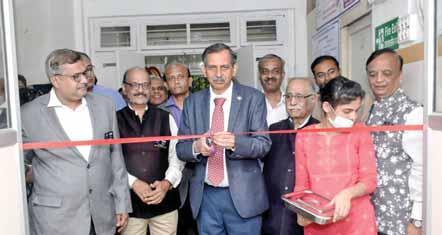
Rotary Club of Poona Midtown, RID 3131, recently expanded the neonatal ICU facility at the Seth Tarachand Ramnath Charitable Hospital in the city with the support of a global grant. PDG Girish Gune inaugurated the upgraded facility.
The project provided eight additional beds increasing the capacity
to 16 NICU beds and sophisticated medical equipment such as warmers, phototherapy machines, incubators, CPAP machines, syringe and volumetric infusion pumps and multi-para monitors that would help save critically ill babies. “The hospital can now treat 800 babies in a year whereas it was 600 babies earlier,”
says project coordinator Subodh Gulavani. The enhanced facility will be a boon for the economically weak community as the hospital charges less than ` 6,000 a day as NICU charges as against ` 25,000 charged by other hospitals, he adds.
The project cost was $72,900. RCs Bethelhem, Lexington After-hours, Lake Nona Lunch and International We Serve Foundation, USA were the supporting partners. RCs Pune East and Pune South were the synergy partners in this GG project. Districts 3131,7430, 6740 and 6060 supported the project with their DDF.
The club provided three-month training to 1,200 anganwadi workers associated with Niramay, an NGO. They were given classes in caring for pregnant women and help them with the safe delivery of healthy babies.
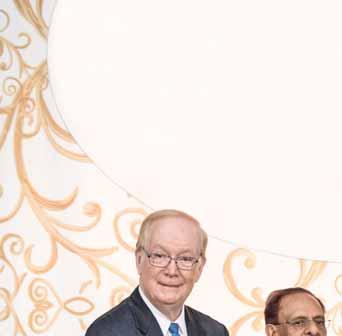
V Muthukumaran
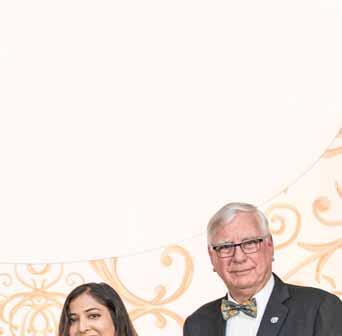
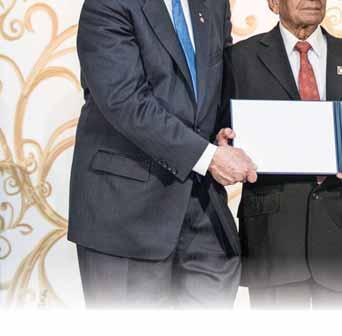
An industrial engineer, Kulbir Dodd was a consultant in top US companies including the Whitehead Institute at MIT, Boston, for over 20 years. He was at the peak of academic and professional excellence, but his passion to improve basic literacy levels in India took over, and he returned to Pune in 1992, became a member of RC Poona North, RID 3131, the next year and founded the MKD Multimedia Knowledge Delivery Trust in 2014 to further the cause of literacy in India. Today he is 94 years old.
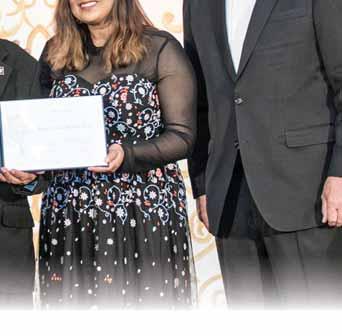
Ever since, MKD — Mira Kulbir Dodd — has become a popular acronym in Pune, Satara and Ahmednagar districts of Maharashtra as thousands of rural students made good use of the MKD tablets distributed by his club, RC Poona North, RID 3131, in partnership with his charitable trust. “So far Dodd has given $528,000 to TRF and was inducted into the Chair’s Circle (double AKS) in 2021 after his last instalment of $100,000. Since 2013, over 3,000 MKD e-learning tablets have been distributed to around 200 government primary schools in rural areas reaching out to over 10,000 students

each year,” said Kumar Shinagare, a confidante of Dodd, who is a Rotarian and a trustee at the MKD Trust. The e-learning devices given to schools with pre-loaded software (in both Marathi and English) for various subjects for Classes 1–7, are being used by 3–4 students at a time under the supervision of teachers. “We update the tablet software whenever the state government brings certain changes in the school syllabus.”
Dodd has given five Term Gifts, each $30,000 to TRF, of which four were converted into global grants for the MKD tablet project and the
Left: Rtn Kulbir Dodd receiving the AKS membership citation, along with his niece Dr Hema Dodd, from the then TRF Trustee Chair Paul A Netzel and RI President Ian H S Riseley at the RI Convention in Toronto, Canada, in June 2018.
fifth GG is under process. “The impact assessment survey done by the Metric Global, an independent firm, has shown excellent results in the learning outcomes in rural students and increasing literacy levels in all schools,” says Shinagare. Comprehension of subjects, pass percentage, class attendance and reduction in dropout rates have all improved with the introduction of tablets in schools. “We have also loaded adult literacy software developed by TCS in the devices so that schools can teach illiterate parents how to read, write and do basic arithmetic after class hours. Parents are very happy to learn from their children who also take lessons for them with the MKD tablets.”
Dodd has donated $300,000 to TRF to set up an Endowment Fund named MKD Tablet Performance Award. Around 50 per cent of its annual return (as interest, dividend, capital gains from the invested money) is being received as DDF by RID 3131 which passes it on to RC Poona North with the condition that it must be used only for literacy projects. “We use the DDF amount to fund GG projects, procure the tablets and train students and teachers to make effective use of e-learning gadgets.”
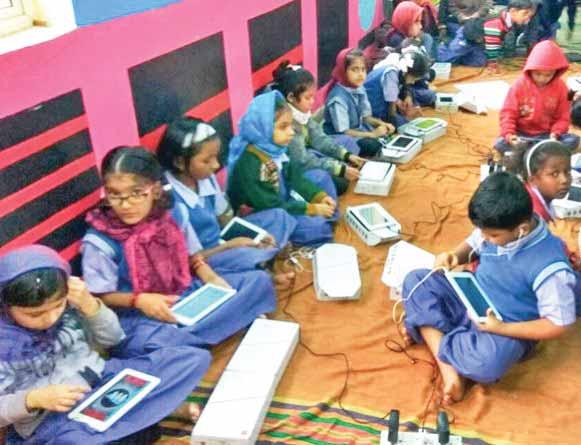
Following the “remarkable change” ushered in by the tablets, clubs from Kerala, Delhi and Kolkata want to replicate this e-learning project for government schools in their regions. “After learning about the MKD’s success story, the Maharashtra government studied our project, bought the same software and has distributed 60,000 tablets to tribal schools.”
RILM chairman PRID Kamal Sanghvi came to Pune in 2019–20, met Dodd, Shinagare and the then DRFC Deepak Shikarpur. He was “much impressed by our tablet project. He is now planning to distribute over one lakh MKD tablets to rural students to begin with,” said Shinagare. RILM wants to roll out this tablet distribution across India in the coming years, he said.
The ‘M’ in MKD stands for Dodd’s wife Dr Mira, a gynaecologist, whom he met during his stint at TELCO, now Tata Motors, in Jamshedpur, before he left for the US. Mira, two
years elder to him, passed away last year. The couple has no children. Dodd, a nonagenarian, is being helped by office assistants who read all his mails, attend phone calls and schedule his official meetings.
Born in Lahore in December 1927, Dodd studied at the Punjab College of Engineering and Technology, Lahore, and after the Partition, worked with TELCO at its plants in Jamshedpur and Pune (1950–62). Then he was chief engineer at the Heavy Engineering Corporation, Ranchi, set up with Russian collaboration, for installing steel plants. Here, he worked for five years till 1967, before migrating to the US. He got a masters in Industrial Engineering from the University of Tuledo, Ohio.
He started a charitable trust in 1990 called Multimedia International Research Associates in the US with the aim to “Teach Through Technology Today”. This NGO has done “some commendable work in America which struggled with literacy goals at that time,” said Shinagare.

ROTASIA 2022, a mega four-day international convention of Rotaractors and Rotaract clubs in South Asia, was celebrated during mid-March at Mahabalipuram, Chennai. RSAMDIO president Arti Goswami and SEARIC MDIO president Kaushal Sahu were the event conveners. PDRR Suresh Manoharan was the event chairman. Over 650 Rotaractors from 32 Rotary districts across four countries converged to enhance fellowship, build networks and exchange information at the event hosted by RID 3232 led by DRR G Kamuvel. “We were super thrilled and charged up to host this mega Rotaract extravaganza in Chennai after 13 years. All

Rotaractors were looking forward to it,” he said. A promotional video by Rtn David Raynel with Rotaractors grooving to music at popular Chennai spots was circulated among Rotaract clubs across South Asia.
RI Director AS Venkatesh, the chief guest, commended the organising team for the grandeur and substance the conference had on offer. DG J Sridhar, RID 3232, was the guest of honour and District Rotaract Committee chair Sesha M Sai energised the audience with his vibrant humour. Rtn Ram N Ramamurthy, RC Madras Mount, was a special invitee. PDRR Sujith Kumar, founder, Maatram Foundation, the keynote speaker, inspired the delegates with personal anecdotes where he did not pass
Above: RI Director AS Venkatesh inaugurates the Rotasia event in Chennai.
Below: DRRE Gowtham Raj being introduced at Rotasia.

up an opportunity to serve the less privileged.
A grand flag march introduced the participating Rotaract districts from India, Sri Lanka, Nepal and Bangladesh. Accomplished musician, 17-year-old Lydian Nadaswaram was recognised with the Young Achiever Award at the conference. TR Sivaram, CEO of Classic Polo was honoured with the Example to Youth Award. The current year DRRs were felicitated for their district leadership during the year.
A session by Rtn Bobby elaborated the amazing work done by Rotaractors as Covid warriors, helping people during the pandemic. A panel discussion on #Elevate Rotaract, following the 2019 CoL that introduced amendments to the constitutional documents to include Rotaract clubs as a membership type of Rotary International, was the major highlight.
Multi-cultural dance performances, stand-up comedy and DJ nights provided the entertainment quotient for the vivacious audience. The conference ended with felicitations to the incoming DRR Gowtham Raj and his team.

RID 3232 DG J Sridhar, Event chairman PDRR Suresh Manoharan, Event convener PDRR Arti Goswami, DRRE Gowtham Raj and Event secretary Vinodh Nagarajan display the t-shirts specially designed for Rotasia.

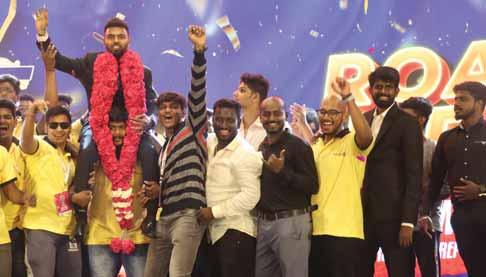
“Rotasia was an exuberant experience for all of us and it gave us an opportunity to develop friendships beyond language, culture and borders, and polish our leadership skills. The event made each one of us proud to be a Rotaractor and be associated with Rotary,” says Sathishkumar, president, RAC Ambattur. For DRRE Gowtham Raj, the mega event was “an incredible experience. The knowledge and the acquaintances made here will be cherished for life. Rotasia 2022 is very special to me as this is the first time I was part of organising such a rich and grand event.”
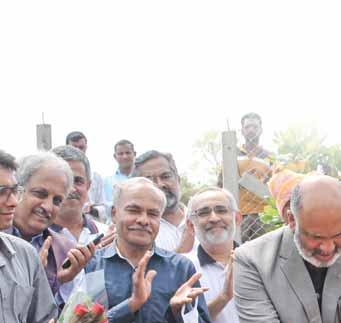
Kiran Zehra



Power humare haat mein hain (We have power),” says Arun Krishna, a 29-year-old-farmer from Mahalenahatti village, 15km from Belgaum in Karnataka. “We had to depend on electricity to pump water to irrigate our fields,” but after RC Belgaum, RID 3170, installed the Smart Aqua Net, a 10kWp solarpowered system for irrigation, “we can work from 7am to 6pm. Unlike the times when we had no clue when the electricity would come. Sometimes the electricity would
come at midnight and we would run to our fields and work in the darkness,” he says.
Project chairman and president of RC Belgaum, Milind Patankar says that the farmers have lived here for generations. “They depend on rain for agriculture and grow one crop a year (either paddy or maize) and post-harvest, the farmers would migrate to nearby cities and work as labourers for the rest of the year, struggling to make ends meet.”
Krishna’s father who is also a farmer “never wanted me to come

to the field. He sent me to college and after I got degree, I took up a job. I always wanted to do farming, researched organic farming and realised I could help my father in so many ways.” He quit his job after four years and went back home “but I was not welcome. My father said that I was getting on a sinking ship and that my life would become miserable. I wasn’t willing to change my decision and began working towards my dream.”
On a trial basis, he started growing chilly, carrots and
potatoes. But irrigating the land was a huge challenge. Meanwhile, RC Belgaum was looking to start a new water and sanitation project when Patankar met Shivajirao Kagnikar, a social worker, who told him about the plight of the farmers.
The club struck a technical partnership with Sun Moksha Power, a Bengaluru-based company that develops and deploys clean and sustainable technology solutions and provides consulting services for rural development and urban sustainability. “We wanted to demonstrate a sustainable model before scaling it up for other farmers and villages,” says Patankar. Kagnikar helped the farmers understand that Rotarians “wanted nothing in return for the help being offered.” The first model was set up on 26 acres of land belonging to 14 farmers, six of them women.
Patankar points out that the smart irrigation model “recommends and delivers the right quantity of water based on the soil, atmospheric and hydrological conditions, and increases productivity
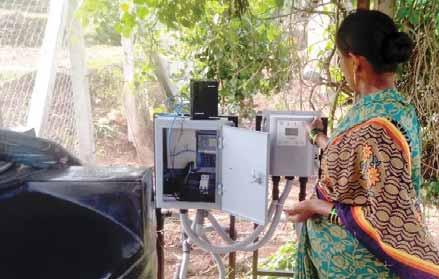
for every litre of water. It promotes shared irrigation and ensures maximum utilisation of irrigation resources and equitable distribution of water to the marginal farmers.”
This automated water management is based on real-time data from the sensors and meters communicating with the cloud network. This helps to conserve and optimise water usage for irrigation, and also ensures a sustainable business model wherein farmers are billed for the water
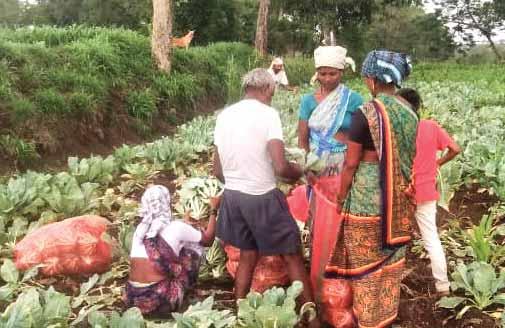
they consume. This infrastructure allows all the stakeholders to monitor the performance of the system remotely and get regular reports on individual farmer’s water consumption, billing and collection.
“The collected money is deposited into the bank account held and operated by the village water committee, Krishidhan Sahayogi Sangha, Mahalenahatti. This money will be used to maintain the system and scale the project. The farmers have also received basic troubleshooting and maintenance training.
The availability of water throughout the year means that Lakshmi’s husband doesn’t have to leave to the city to work at a hotel.
“It feels like finally our prayers have been answered,” says the woman farmer who now doesn’t have to “slog and carry the load of heavy farming equipment alone.”
The project was inaugurated in the last week of March by DG Gaurish Dhond in the presence of Kagnikar, club president Patankar, secretary Laxmikant Netalkar, other members of the club, beneficiaries, and the village community.








Nagpur, now 77-year-old, has set up a Vocational Skills Training Centre at the Providence School Annexe, Civil Lines, Nagpur. DG Ramesh Meher inaugurated the vocational centre in a gala ceremony on Feb 23.
The skill centre is a first-of-its-kind in collaboration with the ICICI Foundation with the aim towards inclusive growth, thanks to the CSR wing of ICICI Bank Ltd. While the club is extending its premises, the ICICI Foundation will provide the faculty, training and placements. Electrical and Home Appliances Repair course (EHA) will be imparted to less privileged children who are looking for a vocation to earn gainful employment. The EHA course will train a batch of 60 students every quarter beginning from May 2022. The programme will train around 150–250 students in EHA every year and would be provided jobs with the efforts of the Foundation.
This will be the first EHA batch to be trained by the ICICI Foundation in partnership with the club. DG Meher praised the services of RC Nagpur as through this project 150–250 students from the economically weaker section of the society will get employed each year.
He expressed satisfaction that such a skilling project was being inaugurated on the Foundation Day of Rotary International. Sushmita Chuckerbutty, centre head, ICICI Academy for Skills, Nagpur, attended the programme and expressed her happiness over starting a unique centre in this city jointly with Rotary.

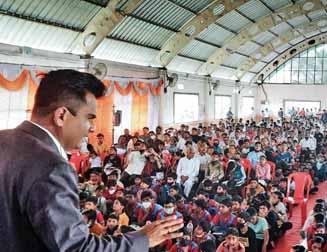
Memorytrainer Dr
urged the students to adopt various tricks to memorise their subjects. While rhymes and pictures are found in plenty in the books of Classes 1–5, these are reduced and paragraphs increase from Classes 6–8.
Addressing students at a special workshop, Dr Gadhe said they should focus on comprehension and extemporisation, rather than rote learning. The workshop was organised jointly by RC Bhusawal Tapti Valley and the Chate English Medium School. He demonstrated how to memorise the words and remember phone numbers which will be useful in our daily life. He listed various plans with solutions to tackle problems in subject study.
Around 4,000 students took part in the study workshop. Dr Gadhe advised the parents to guide their children on proper ways to memorise their subjects. Dr Sanju Bhatkar, president, RC Bhusawal Tapti Valley, said that as students have lost nearly two years of schooling due to the pandemic, some have dropped out of mainstream education due to many reasons. They were learning through online over the last two years, but this is not the proper way and students have to attend classes in regular schools for good education. Club treasurer Sunil Wankhede gave the vote of thanks.

To provide a secure livelihood source to disadvantaged women, RC Kalwan joined hands with the Jankai Madhyamik Vidyalaya to start a Sewing Training Centre with the support of Singer Machine India Ltd. Jankai Sanstha chairman Chandrakant Kothavade led this project.
DG Ramesh Meher, Surgana MLA Nitin Pawar and RC Kalwan president Nilesh Bhamre were present at the inaugural ceremony of the tailoring centre. Rtn Vilas Shirore gave a presentation on the work done by Rotary in this project. MLA Nitin Pawar appreciated the work and dedication of the club. Women can become self-reliant after getting trained at this sewing class, he said, and expressed his readiness to help any project that empowered women. Club president Bhamre said the project would be sustained for five years.
He said it will provide self-employment to hundreds of women through modern fashion designing lessons at a reasonable fee. There are 21 machines available in the centre to train women and those who have completed the three-month course will be given a government-approved certificate. The Singer company will give the pass-out candidates with a sewing machine at a 50 per cent discount.
A galaxy of local officials, Rotarians, social activists, teachers, academicians, sewing class instructors and Inner Wheel club members took part at the inaugural ceremony.
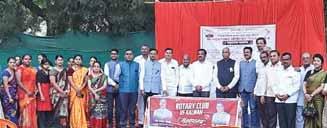
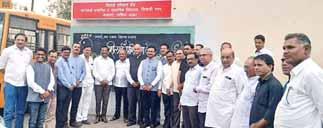





RC Nasik City hosts ‘Jeevan Urja’ RYLA

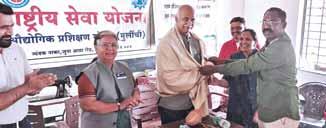
Jeevan Urja, a five-day RYLA, was organised by RC Nasik City for 45 NSS girls of ITI Girls College with DG Ramesh Meher inaugurating the youth programme. The RYLA was organised at the Laxman Pada, Trimbak, wherein the participants trained the Adivasi girls in beauty parlour, electrical and sewing courses.
Also, basic defence techniques, rangoli and drawing skills were imparted to tribal girls by student participants. The programme showcased human values and the club plans to lay at least 5km approach road to this tribal hamlet with the help of villagers. The club’s vocational director Madhav, secretary Kiran, Rtns Chokani, Naresh and Amol were present at the closing session of Jeevan Urja
The RYLA teams gave basic training on sewing machine to 10 girls; beauty parlour course was taught to another 10 girls; and electrical wiring skills were imparted to 15 beneficiaries. The club donated 10 sewing machine kits, two sewing machines, 10 beauty parlour kits and 10 basic electrical kits to Adivasi girls. Rotarians urged the beneficiaries to be financially independent through self-employment. A group of female doctors from Bosch company engaged the girls on menstrual hygiene which brought the curtains down on an eventful Jeevan Urja

My journey in wildlife photography began in 2006. I have vis-
ited the Project Tiger forests — Kanha, Nagarhole, Pench, Nagzira, Navegaon, Ranthambore, Bandhavgarh and Tadoba, all national parks and tiger reserves — as the big cat is my most favourite animal. However, Bandhavgarh, Pench, and Tadoba

remain my favourite forests, because of the opportunities for the sighting of tigers and the diversity of the forests.
Tiger sighting is a very tricky thing in the forest. You require some amount of luck along with a professional guide and photography gear.
I have been blessed with some memorable sightings in Bandhavgarh National Park and that’s why
Bandhavgarh is my most preferred forest. Some of my Bandhavgarh memories, captured in my camera, have won me many prestigious International and National Awards in Nature and Wildlife Photography.
The wait
During my visit to Bandhavgarh in May 2019, we got news that a tigress called Dotty and her cubs were seen roaming in the Magadhi zone. Therefore, in my next safari, I decided to visit that area. It was summer and I had high hopes of seeing the tigress and her cubs or some other predators visiting the waterhole to quench their thirst or to just cool off.
As we started our safari early at 6 am, we began to hear some alarm calls of deers and Grey Langurs
(monkeys). The calls were getting stronger and stronger; so we decided to wait near a waterhole in the Magadhi area. But after a while, the alarm calls stopped completely. For almost half an hour, we could not sight any predator. The other safari Gypsies started to leave the spot.
But I had decided to try my luck. I told my guide and the driver not to move anywhere; no matter even if we drew a blank. Luckily, they agreed and we sat quietly watching the thickets and bushes around the waterhole.
As I had woken up at 4 that morning, after an hour’s wait, my ears and eyes had begun to give up. I was almost dozing off when suddenly, my guide poked me saying: Saab, andar kuch movement hote sunai de raha hai… taiyyar rehna! (Some movement is happening, be ready). As he spoke, we began to hear the alarm calls again, especially from the langurs. There was massive movements in the bushes and the shrieks grew louder. I became alert; ready with my finger on the camera trigger… and within minutes, we witnessed a tigress coming towards the waterhole, along with her three gorgeous cubs.
Dotty emerges with her cubs
Here in front of our eyes was Dotty with her cubs! The cubs were sub-adults, almost 14–15 months old, and were in a playful mood. While coming towards the waterhole, one of them had hunted a langur. That explained why the alarm calls were so frantic, especially by the langurs.


The hunter-cub was jubilant and proudly showing off his trophy to the other members of the family. Soon their mother Dotty, who was not keen to enter the waterhole, decided to take a nap behind a tree. And that opened the floodgates for the cubs to freak out in the waterhole. All three were enjoying their playtime and the hunter began the ‘catch-my-trophy-if-you-can’





game with the other cubs. It was a terrific show, which appeared to me as if a water polo game was going on.
There were mock fights and the entire waterhole area became a sports arena. Boxing, wrestling, racing, punching, chasing… it was sheer delight to the eyes of any photographer. I tried to freeze some of these unforgettable moments on my camera. This turned out to be one of my best sightings ever.
By the time the show ended, I had finished half of my camera’s memory card. I will surely visit Bandhavgarh in the future. But will I ever witness such an awesome sighting again? I doubt it.
The writer is a member of RC Koregaon Park, RID 3131
Designed by Krishnapratheesh S
V Muthukumaran
Astrategic decision was taken by Rotary in India to build toilets and hold health camps in government schools when Census 2011 put the country’s literacy rate at 74 per cent. “In the next 10 years, we constructed 12,000 school toilets and held 24,000 health camps in government schools in our bid to achieve total literacy… that is 95 per cent. So far, we have installed 10,000 smart classrooms across schools in India,” said RI Director AS Venkatesh.

Speaking at a gathering of over 900 students, teachers, district education officials and members of RC Madras, RID 3232, at the inauguration of two toilet blocks — one for the students and the other for the faculty — at the Government High School at Sithalapuram, a city suburb, he said “wherever there are inadequate toilets, girls are vulnerable to diseases and they drop out of school eventually.” At a health camp conducted at a school in Kattankalathur, a southern suburb, “we found that a Class 5 boy, a habitual backbencher and ridiculed by teachers, suffered from an eye disorder and hence could not see what was written on the blackboard. We detected the vision problem, treated it and within

a few months, he was a top ranker in his class.” Urging students to study hard and take up meaningful careers, Venkatesh hoped that once they attain a certain status in life, they would help other underprivileged children. To ensure proper maintenance of the toilet block, he said each of the 48 toilet units can be assigned to a class section and “at the end of the year, the school can hold a contest for the best maintained toilets and prizes can be given to students who have done a good job.”
Seeing the happy faces of girl students, “reminds me of my childhood days at my village where girls were reluctant to attend school for many reasons,” said DG J Sridhar. He lavished praise on the club’s



WASH chairman and presidentnominee Ravi Sundaresan for taking up meticulously the work involved in the global grant project which took over 3–4 years to complete.
Giving an overview of the project, Sundaresan said eight entities — RCs Madras, Bath (RID 1200), Croydon Whitgift (RID 1145), Warwick (RID 1060), UK, and their respective RIDs — have come together to construct the toilet blocks worth `30 lakh. The gender-segregated toilet block for students has six handwash stations to practise group handwashing; while another toilet block for staff has two handwash stations. There is availability of adequate water through overhead tanks.
In2015, RC Madras initiated an End Polio Now flame voyage across the world under the leadership of the then president SN Srikanth with Rtn NK Gopinath holding the torch as EPN Flame chair. “In the UK leg of the voyage, RC Bath was one of our stops. Rtn David Broughton from that
UK club had asked his colleague Rtn Brian Joakim to get in touch with me to talk about this sanitation project,” recalls Gopinath. “Broughton, who handled the EPN flame then, was in regular contact with me. The whole idea of building a toilet block was first mooted by Joakim with support from Broughton and past presidents of RC Madras,” he explains.

India is one of the countries in the pilot programme launched in 2016 by RI called WASH in Schools Target Challenge which takes up sustainable water, sanitation and hygiene projects in schools that are integrated with the basic education and literacy goals. “RC Madras is taking up WASH projects after following a ‘needs
assessment’ at schools. We are able to complete this project with cooperation from the school headmistress, PTA head and the teaching faculty,” said Sundaresan.
With the new sanitation facilities, the school can now accommodate 1,400 students and has surpassed the UNICEF and WHO benchmarks.
“It now fulfils one of the prime requirements of a higher secondary school,” he noted. Nalamthana, an NGO, had conducted awareness sessions for students on proper use of the toilets and the need to maintain them.
constructed the sanitation facilities and its proprietor R Rangasamy assured that his firm will provide free maintenance for three years.
L: RI Director AS Venkatesh, Vinod Saraogi, DG J Sridhar and club’s presidentnominee Ravi Sundaresan.

In his address, club president Mohan Raman said he was beholden to past presidents NK Gopinath, SN Srikanth, Ranjit Pratap and Dr Vijaya Bharathi for taking the project through successive stages which “enabled us to inaugurate the grand toilet blocks today.” He assured the faculty that any future demands of the school will be met by the club. “We are ready to install 17 smart classes in different schools; and the classrooms of 12 schools will be revamped with ceiling fans, blackboards and other needbased WASH infrastructure under our Schools into Smiles project which will be completed by April,” said Raman. Adhilakshmi Builders has
District educational officer R Rajasekaran said it was a momentous day for the school which was badly in need of sanitation facilities and thanked the club. K Keerthana (Class 8) smiled and said, “now we don’t need to stand in queue before the toilets. We had earlier four toilets for girls and another 5–6 for boys, but they were in poor shape. The new block will ensure we don’t miss classes.” Headmistress Sweetlin Rani said the school is still in need of eight classrooms, a science lab and a smart classroom. “Right now, we have 14 classrooms with 901 students. Also, the height of the compound wall has decreased with the laying of a new road and it needs to be raised by a few metres.”
When the Rotary project began, they had around 600 students, “but seeing the construction of a new toilet block more parents came forward to admit their wards. The school located in a marshland of 6.7 acres has to contend with wild grass and bushes which need to be cleared and the terrain levelled for creating a playground for the students.
Picture by V Muthukumaran


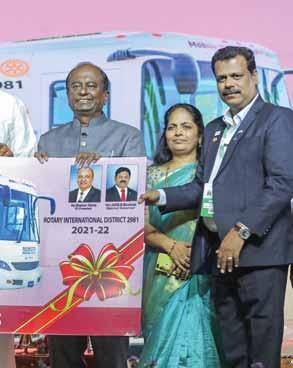

Tamil Nadu Legislative Assembly Speaker M Appavu launching the mammography bus in the presence of (from L) DG S Balaji, Conference chairman M A Mohamed Ziaudeen, Justice R Subramanian, RI President’s Representative Raja Seenivasan and his wife Jayanthi, and DRFC V Raman.
Rotary District 2981, led by DG S Balaji, celebrated its district conference in Chennai for three days recently. To commemorate the event the district launched three humanitarian services — a mammography bus worth ` 1.75 crore that will be driven across Tamil Nadu and
Puducherry to help early detection of breast cancer; Project Orange worth ` 2.25 crore to set up 16 vision centres across Tamil Nadu; and three ambulances to serve patients. The ambulances were given to three Rotary clubs chosen through a lucky draw at the conference and the clubs will
use the vehicles to help underprivileged patients. The projects were funded through global grants and sizeable contribution from Rotarians.
DG Balaji walked the talk by contributing more than `1 crore towards these projects and he became the district’s first AKS member,
said RID 3232 PDG V Raja Seenivasan who was the RIPR for the conference. Appreciating the conference for taking up a good mix of Rotary topics and other meaningful sessions, he said that the event can be easily rated as one of the best conferences. This year the district, with a membership strength of
6,500 Rotarians, added 1,500 new members and contributed about $300,000 to The Rotary Foundation. “This is no mean achievement as there are no big cities in this district,” said the RIPR.
The district includes 135 Rotary clubs across seven revenue districts — Thanjavur, Tiruvarur, Nagapattinam,
Doing good with TRF help
Mayiladuthurai, Cuddalore, Puducherry and Karaikal.
Speaker of the state Legislative Assembly M Appavu, the chief guest, appreciated the district’s Rotary clubs for their community service activities, especially the adoption of 135 backward villages. He said that the project
was similar to the state government’s programme to transform villages and equip them with proper infrastructure.
Justice R Subramanian, Judge, Madurai Bench, Madras High Court, was the guest of honour. He commended Rotary’s women’s empowerment initiatives and urged the Rotarians to
educate schoolchildren on personal hygiene and adolescent health.
MA Mohamed Ziaudeen was the conference chairman.
A variety of cultural programmes and distinguished speakers drawn from various fields kept the audience engaged and entertained throughout the conference.
RC Rasipuram, RID 2982, implemented a global grant project at the Sacred Heart Higher Secondary School and turned it into a Happy School with a host of new sanitation facilities. The project worth ` 27 lakh benefited more than 1,000 students.
Two smart classrooms, 25 desktop computers, an RO unit for drinking water, an exclusive toilet block for girls with sanitary pad incinerator and a handwash station were executed as part of the Rasi Rotary Happy School Project. “A need assessment was done by the club’s Foundation Committee by visiting the school and interacting with the school management committee and the headmaster,” said NP Ramaswamy, primary contact of the club.
While training of teachers in the operation of a smart class was given by the vendor Tata Edge, the hands-on training in computer education was provided by ICT teachers from the State Council of Educational Research and Training. The club roped in
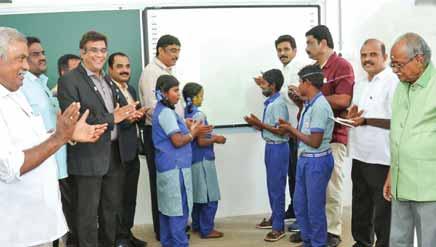
A smart classroom being inaugurated by DG K Sundharalingam (third from L) in the presence of PDG KS Venkatesan (second from L), project chair S Balaji, club president Anbalagan (third from R) and club contact NP Ramaswamy (R).
an NGO — Integrated Development Initiatives and Alternatives Foundation (INDIA) — to teach students effective use of handwash station and toilets.
RC Kent, RID 5030, the global partner contributed $7,000 for the WinS project. “We completed the project in four months and inaugurated the facilities to coincide with the reopening of the school after a long spell of Covid lockdown.”
DG K Sundaralingam, IPDG KS Venkatesan, district stewardship chair PDG TS Shanmugasundaram and DRFC Babu Kandaswamy were present at the inauguration of new WinS facilities. Club president Anbalagan presided over the inaugural event. Past president S Kathiresan and project chair S Balaji spoke about the implementation process.
For more than 25 years, the members of RC Deonar, RID 3141, have nurtured the concept of Rotary Community Corps (RCC) in the Karjat taluk of Raigad district, Maharashtra.
The work at an RCC is always a joint partnership between the Rotarians and the RCC team comprising the villagers residing in the area. The villages near Deonar have seen considerable development since the club’s intervention.
It all started with Shelu, a village in Karjat taluk where the club installed its first RCC. Today the club has installed five RCCs covering 46 villages in this taluk, transforming the lives of over 100,000 people.
The journey began with a focus on polio eradication in the village where several children were affected by polio.
With the help of the RCCs the club had sponsored 130 polio corrective surgeries across the villages and this helped in deepening the bond with Rotary among the locals.
The RCCs helped in identifying a group of villagers for a vocational training (VTT) programme to Israel that was done with an intent to understand agricultural practices
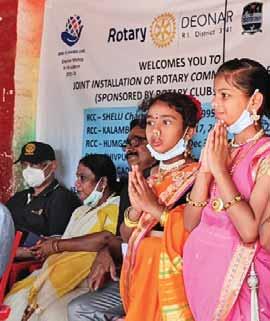

Clockwise: A hand operated borewell being inaugurated by Rtn Usha Desai in the presence of members of RC Deonar and RCC members; Village children perform a prayer song at an RCC installation; AKS member Kulbhushan Jetly inaugurates a hand operated borewell in a village; Classroom furniture sponsored by an RCC for a village school.
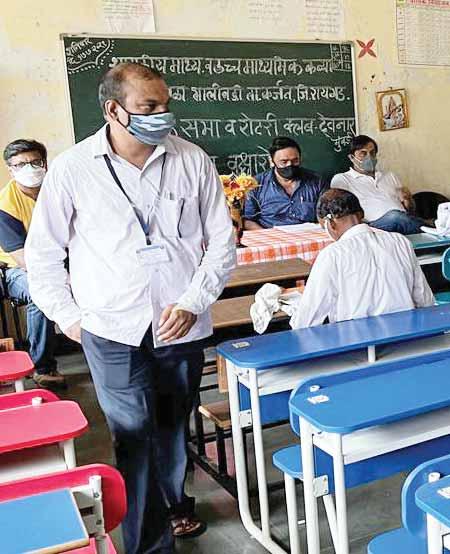

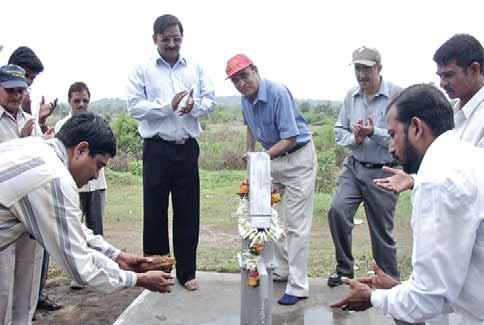
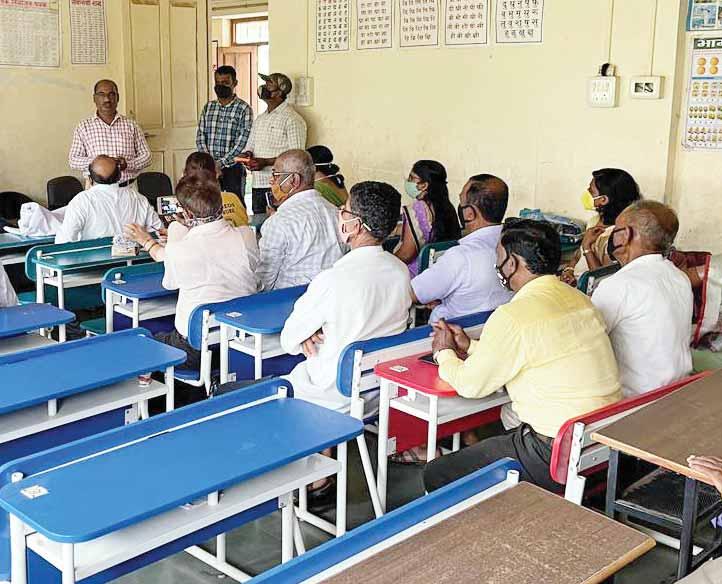
and improve crop yield. Over the years, the learning has immensely contributed to enhancing the local produce.
Other areas where the RCCs have helped in uplifting the lives of people include encouraging organic farming and women’s empowerment programmes. Village development initiatives include check dam projects, providing drinking water for village communities and schools, public utility toilet blocks. medical facilities, upgrading infrastructure in schools, promoting sports in the villages and vocational training for youth and women.
While the above may not be an exhaustive list, what is crucial is consistency in ideation leading to implementation and ensuring sustainability is monitored.
Club members Kulbhushan Jetly, Satish Lamba, Jhankar Gadkari, Ajit Pappu, Nagesh and Kannan have contributed immensely to the ongoing development. With the change of guard every year, each president has given strong support to the continuation of projects and initiatives that have been running for years.
The development of leadership at the local level plays a significant role and that is where leaders like Arjun Tare, Sitaram B, and many such pillars have made the RCCs what they are today.
One of the remarkable transformations that has come through this dedicated work is building new lines of leadership. In Oct 2021, RCC Bhivpuri appointed its first woman president, Archana Deshmukh. The writer is member of RC Deonar, RID 3141
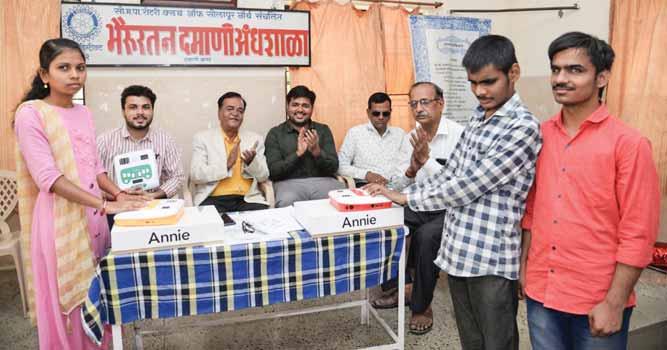
After two years of shutdown due to the Covid pandemic, the Bhairuratan Damani Blind School in Solapur reopened in February and the sense of elation and relief among the 48 visuallyimpaired boys and girls was quite palpable. “We had provided smartphones to senior students who can handle them and through a mobile app designed for the blind, they
learnt their subjects without a break even during the lockdown,” said Dr Vijay Degaonkar, president, RC Solapur North, RID 3132, which is running the Braille school up to Class 7.
This residential school for the blind has been offering free education and boarding since 1987. “The Solapur Corporation gave us the Samaj Mandir, a community building on a 2.5-acre plot of land, when they

found that we are looking for land and building to educate the blind,” he recalled. Industrialist Premratan Damani who owns large parcels of land and runs a cotton mill in Solapur, along with other businesses, came forward to renovate the government building, added one more floor, and the new school was named after his late father Bhairuratan.
Apart from teaching the curriculum in Braille, the school provides vocational training such as making agarbattis, candles, office files and envelopes. “In 2021, we installed four handlooms (legless looms) that are disabled-friendly and can be operated by the visually- impaired students. Household accessories such as table linen, bathroom mats, curtains, upholstery and other niche garments are weaved by using
the waste and discarded textiles,” he said.
During festivals and special occasions like Diwali, Independence and Republic Days, “we look forward to the cultural programmes hosted by the students. It is lovely to watch the dedication of these sightless children as they perform with great enthusiasm,” said Dr Degaonkar. “While we have a capacity to accommodate 80 students, due to the pandemic the number has dropped to 48.”
While the club’s IPP Poonam Deodas donated two handlooms (each worth ` 60,000), two other members, Dr Siddeshwar Wale and Anand Sadhul sponsored the other two weaving units. “On an average 25–30 students pass out of Class 7 and so far, around 400 students have completed their schooling here,” said
MK Ashtagi, club’s membership director. Satisfied with the school’s performance, the state government has donated nine digital computer programmers worth around ` 9 lakh which can convert data (words, arithmetic) into Braille. “These portable digital machines will enhance the knowledge of students as they can now source diverse content from the internet and refer hundreds of books across genres from the library. This will facilitate better understanding of their subjects,” said Dr Degaonkar.
Headmaster Prakash Darshanale, a former student, runs the school with six teachers whose salaries are paid by the state government. When the students pass out of the school, the headmaster helps them to get admission in other mainstream schools and “after graduation, they

School bags given to children at the reopening of the school in the presence of (from L) club’s past president Dr Siddheshwar Wale, Lalita Somani, Prakash Somani, club president Dr Degaonkar, school secretary Bhandari, headmaster Darshanale and project coordinator Vibhishan Kadam.
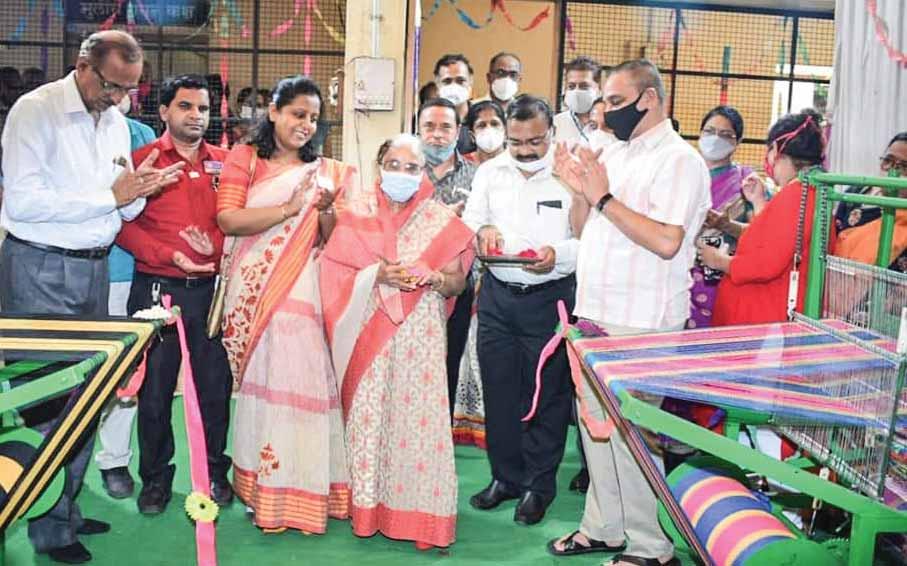
are given MSCIT (Maharashtra State Computer Internet Training) certificates to help them get employment.” Damani School takes care of the daily expenses, tuition fees of its former students till graduation. They are allowed to stay in the hostel while
On an average 25–30 students pass out of Class 7 and so far, around 400 students
would have completed their schooling here.
MK
pursuing higher education as the school gets regular donations from the public and corporates. The relationship with the school is lifelong as the institution helps graduate students find jobs and also solemnises their marriage with liberal financial assistance for them “after finding a suitable alliance through networking,” he adds.
“The club meets the monthly expenditure of ` 40,000– ` 45,000 for the school through member contributions, public donations and funding from corporate houses. Also, donor Premratan’s family contributes at least ` 2 lakh for the school each year,” says Ashtagi. All the 75 members of the club, formed in 1974, contribute each month for the administrative cost of the school. “Many of the school’s alumni are now in top posts in district collectorate
offices; while some have excelled as engineers and government servants,” he said.
Sharing an anecdote, he says, “a few years back, parents of Atul Thakur, now studying in Class 7, were devastated as their son could not get admission in a school. But a group of teachers from the Damani School, during a visit to Thakur’s village in Barshi taluk, convinced his parents to let him go and stay in their boarding school which is around 50km from their place.” Now Thakur is a top ranker and also a district chess player. “His parents are really happy that their son’s future is now secure.”
Another permanent project of the club, Radhakisan Fomra Deaf and Dumb School which it took over from a charitable trust in 1977 has 87 special children on its rolls.

A beneficiary receives a certificate after completing the vocational training programme.
RC Tiruchirappalli Butterflies, RID 3000, in association with Nippon Paints, organised a 15-day vocational training programme for underprivileged women to learn wall painting. Eight women who completed the course were given certificates.
Rotarian becomes cabinet minister

Dr Vijay Singla, member of RC Mansa, RID 3090, was inducted as the health minister of Punjab. Singla is the first MLA in the district to become a cabinet minister since Mansa was bifurcated as a separate district from Bathinda in 1992.

Anna University’s Alagappa College of Technology, Chennai, and AC Tech Alumni Association honoured PDG V Raja Seenivasan with the AC Tech Distinguished Alumni Award under the Industry, Management and Entrepreneurship category. He received the award from Tamil Nadu Governor RN Ravi.

RC Karamadai, RID 3203, has constructed a sports facility with volleyball, shuttle and cricket net practice courts at a cost of `7 lakh. DG K Shanmugasundaram inaugurated the facility.
In a mega WASH in Schools (WinS) initiative, RC Madras Central, RID 3232, built a slew of sanitation facilities and renovated classrooms at three government schools, which will benefit around 4,400 students. This is through a mix of global grant ($31,000), CSR funds and member contributions under the first phase of its Happy Schools project.
DG J Sridhar inaugurated three handwash stations (HWS), six RWH wells, a refurbished RO plant, a revamped noon meal area and handed over benches, blackboards and sliding doors at the Chennai Girls HS School, Shenoy Nagar. The club has also
redone the electrical wiring, donated a photocopy machine and strengthened the lab facilities at this school with 1,690 students. The project was initiated last year by the club’s IPP Supriya Sundararaman.
Addressing the meeting, Sridhar urged the students to learn proper handwashing and “go home and inform your parents what the school has taught you about personal hygiene so that your entire family can benefit.” The English medium school is still in need of some more facilities, he noted, and “we will visit the institution again to set up a borewell to replace the defunct one.”
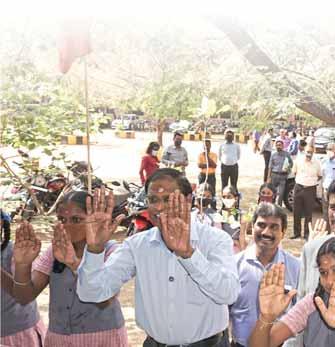
Club advisor and director, special projects, Vinod Saraogi said “proper training on menstrual hygiene will be given to students. The school was referred to us by one of our close associates and the headmistress has extended full cooperation and support in implementing the WinS project. We want this to be a model school and the refurbished noon meal area is one of the highlights of the WASH facilities.” A team from World Vision will give a one-year training to students on proper use and maintenance of HWS, he said. Also, the parent-teacher association has been roped in to facilitate this learning process. The total project
DG J Sridhar gives a demo of handwashing, along with girls, at the Chennai Girls HS School in the presence of (from Left) RC Madras Central President KAV Ramesh Kumar, club advisor Vinod Saraogi and IPP Supriya Sundararaman.
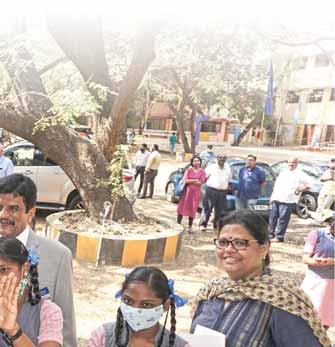

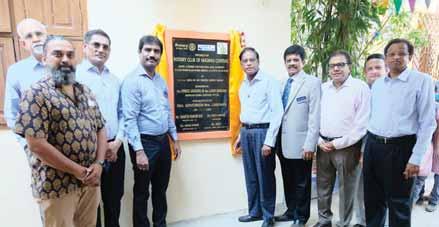
DG Sridhar inaugurates a renovated noon meal centre in the presence of (from L) club secretary Harish Kumar, DRFC M Ambalavanan, club president Ramesh Kumar, Saraogi, district WASH chair V Ramani, community development chair SN Balasubramanian and M Gopinath.
cost is around `50 lakh, said Saraogi. Headmistress N Chinnavellaithai, expressed her gratitude to Rotary.
Similar Happy School facilities were inaugurated at the Jaigopal Garodia Government Girls HS School, Ponneri, a Chennai suburb, and the Government HS School,
RC Chandigarh, RID 3080, installed a high dependency unit (HDU) equipped with 16 mechanised beds with air mattresses, high-end monitors along with compatible UPS, and a portable endoscopic equipment, together costing `53 lakh, at the Government Medical College and Hospital. Inaugurating the HDU, Dharam Pal, advisor to the administrator, Chandigarh,
Kathivakkam, by Sridhar. While two toilet blocks, four buildings with 40 classrooms were renovated and pathways between blocks were redone at the Jaigopal School, apart from four new HWS; at the Kathivakkam school, the club renovated 15 classrooms, a girls’ toilet block, provided three HWS and repaired the assembly floor.
In the second phase, the club will install WinS facilities and renovate buildings at three more government schools. RCs Cataraqui-Kingston, RID 7040, Canada, and Medicine Hat, RID 5360, Australia are the global partners.
Club president KAV Ramesh Kumar said, “we are a 40-year-old club with 95 members who have taken up long-lasting, sustainable, multifaceted projects.” The Rotary Central VHS Blood Bank has been doing yeoman service for over 30 years and the Rotary Central Prahlad Rai Bone Bank, a $100,000 project done with the Adyar Cancer Institute, preserves the donor bones which are then used for cancer patients, accident victims and surgeries. Assistant educational officer N Thangamani, club secretary Harish Kumar, DRFC M Ambalavanan and other members were present.
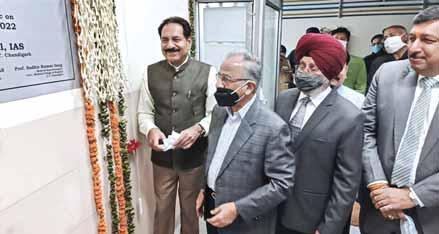
PRIP Rajendra Saboo with Dharam Pal, advisor to the administrator, Chandigarh, at the inauguration of the high dependency unit at the government hospital.
commended the Rotarians for their prompt response in providing an adequate facility for the patients at the hospital.
The project was implemented with the help of RC Greater Lake
Charles, USA, and TRF, said project coordinator PDG Madhukar Malhotra. PRIP Rajendra Saboo, club president Jaspal Singh Sidhu and the hospital officials were present during the event.
















S R Madhu
Talat Mahmood is the only singer who hasn’t been copied by others,” Lata Mangeshkar remarked once. Ace composer Anil Biswas often asserted that Rafi, Kishore and Mukesh had many clones while Talat didn’t — because no one could imitate him. His voice, with its unique tremor or quiver, could never be cloned. But it arguably inspired more lyrical eulogies than Madhubala’s beauty did. Talat’s songs flowed like moonlight over water, said Outlook magazine. They fell on your ear
like soft petals on wet earth, said Ganesh Anantharaman, a music critic.
Talat was considered the king of ghazals (poems of love, often unrequited love and loss). Kings were his fans. He was gifted a Persian carpet by King Zahir Shah of Afghanistan, and a beautiful ornate bell by King Birendra of Nepal. He once overwhelmed King Birendra by composing to music and singing a lyric written by Birendra.
Americans described Talat as the Frank Sinatra of India. Interestingly enough, India’s Frank Sinatra

passed away on May 9, 1998, and America’s Frank Sinatra died five days later.
Talat sang 747 songs in 12 languages, including 450 Hindi film songs, in a twodecade career. A relatively low output in comparison with the thousands of songs credited to Lata, Rafi or Kishore.
Yet, Talat is the favourite singer of millions round the world, who get mistyeyed on hearing his name. They regard
him as the epitome of class. That velvet softness of his voice; its sweetness and pathos; the elegance of his intonation; that allconquering tremor — it’s a cocktail that spells magic. There can be only one Talat, his army of aficionados insist.
Talat was born in Lucknow on Feb 24, 1924, one of six children of Sheikh Manzoor Mahmood. Talat was keenly interested in music even at a young age, and would enjoy sitting

through all-night music soirees. His father bought him a gramophone player and some records of KL Saigal, and young Talat was forever at the gramophone, absorbing and memorising Saigal. He later studied at Marris Music College in Lucknow. For his entrance test at the college, he flunked theory. But the college authorities were amazed at the alaap he sang for the practical test — they realised that they were seeing extraordinary
talent. News of his talent reached All India Radio, and he sang the ghazals of Mirza Ghalib and other great poets on AIR Lucknow. He cut his first disc in 1941 at the age of 17.
In 1944, at the age of 20, Talat’s Tasveer teri dil mera behela na sakegi took the country by storm, and sold more than 100,000 copies. It remains one of the biggest nonfilm hits even today. The Calcutta film industry was quick to tap his genius and also
persuaded the handsome youngster to act. Talat sang several songs and acted in three of his 13 films in Calcutta. He treasured all his life his meeting with Saigal when the legend was recording the song Ek bangala bane nyara.
In 1949, Talat moved to Mumbai. Saigal was no more, and it was the right time for a talented new ghazal singer to make his mark. The following year, Talat’s song of despair in Arzoo filmed on Dilip Kumar and composed





by Anil Biswas became a rage. Ae dil mujhe aisi jagha le chal jahan koi na ho was a chartbuster. This was the first of numerous exquisite songs that Talat voiced for Dilip in subsequent years. These included Duniya badal gayi and Mera jeevan sathi bichad gaya (Babul, 1950), Nain mile nain hue bawre and Seene mein sulagte hain arman (duets with Lata in Tarana, 1951), Ae mere dil kahin aur chal (Daag, 1952), Yeh hawa yeh raat yeh chandni



















(Sangdil, 1952), Shamegham ki kasam (Footpath, 1953). Each of these songs was a jewel. Talat’s voice helped immortalise Dilip’s image as the tragic lover.
Dilip wanted Talat always as his playback, but Talat had antagonised Naushad (Dilip’s all-weather composer) by smoking on the sets of Babul before recording a song. Naushad banished Talat from his music, and thereby from Dilip’s films.
But Talat’s wonder voice and its impact captivated the industry. He recorded the immortal Jayen to jayen kahan composed by SD Burman for Dev Anand in Taxi Driver (1954); and memorable hits like Meri yaad mein tum na ansu bahana for Manher
Kumar in Madhosh (1951); Main dil hoon ek armaan bhara for Raj Kapoor in Ashiana (1952); Chal diya kaarvan (Laila Majnu, 1953) and Aye gham-e-dil kya karoon (Thokar, 1954) for Shammi Kapoor; and Sub kuch luta ke hosh me aye to kya hua for Ashok Kumar (Ek Saal, 1957).
Talat was riding high, and the acting bug bit him. Producers believed that with his dashing good looks and his singing talent, he could be a crowd-puller as a singing star, and Talat got tempted. For his film Dil-e-Nadaan (1953), producer-director AR Kardar launched a national beauty contest to find a heroine for Talat. Peace Kanwal was selected.

Between 1951 and 1958, Talat acted in 10 films opposite Madhubala, Shyamala and Peace Kanwal, Nadira, Suraiya, Mala Sinha, Shyama and Nutan. They were unspectacular and public response was tepid, but Talat sang some exquisite songs in these films — such as Zindagi denewale sun (Dil-e-Nadan), Jhoome re (Ek Gaon Ki Kahani)and Pyar par bas to nahin hain mera lekin phir bhi (Sone ki Chidiya).
Talat’s foray into acting turned out to be ill-advised. It didn’t excite the public, and it meant far less time for music. He was soon to realise that he was no match for Dilip’s charisma, Dev Anand’s charm and flamboyance or Raj Kapoor’s studied artlessness. Shammi Kapoor asked Talat why he was wasting his time acting, when he could sing so well.
Talat decided to pay heed and focus on singing once more — but his time had passed. Mohammad Rafi dominated the playback scene and was every producer’s first choice. Popular taste had changed too. Melody had given way to rhythm. Ghazals were replaced by jazz and pop and the electronic rhythms of the disco generation. Gentle romance had given way to colour, spectacle and noisy escapism. Talat himself said that Shammi Kapoor — who had rendered the heartrending ghazal Ae gham-e-dil kyakarun on screen in Talat’s voice in Thokar (1954) — now yelled Yahoo through Rafi!

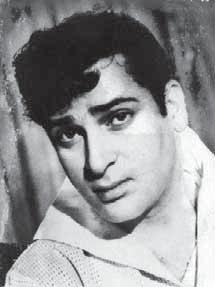

Talat had to be content with a song here and there, and occasional triumphs didn’t create a wave. Humse aaya na gaya in Dekh Kabira Roya (1957) was a classic. Jalte hain jiske liye (Sujata,1960) was not merely a hypnotic song, it immortalised the image of Sunil Dutt singing on the phone to Nutan. Thousands of young men in India have since sung to their sweethearts on the phone. But composers didn’t inundate Talat with calls.
Dilip wanted Talat to sing Suhana safar in Madhumati (1957) but Talat himself urged Dilip to call Mukesh, who was then hard up. “The famed gentleness of Talat
was not confined to his voice alone,” says Anantharaman. The song was a hit and helped revive Mukesh’s career; he was profuse in his gratitude to Talat.
Madan Mohan got Talat to sing the major songs of Jahan Ara (1964), against the wishes of the producer who wanted Rafi. Phir wohi shaam wohi gham in this film was a gem and a chartbuster. Teri aankh ke aansoo pee jaoo was another memorable number. But the film flopped, and didn’t help the careers of either Talat or Madan.
The failure of Jahan Ara upset Talat and he decided in the mid-1960s to stop singing in films, but continued to perform in stage shows,


particularly abroad, where he always got a tumultuous reception. In 1956, Talat had done a 45-concert tour of East Africa (though only six concerts had been planned). It was the first foreign concert tour by an Indian playback singer. He toured Pakistan a few times; he was a cult figure there, and was both lionised and romanticised. In 1961, a record crowd of 58,000 fans packed the Karachi stadium. EMI, Karachi, honoured Talat with a silver disc. Noor Jahan called from Lahore to request Talat to join her at a concert, and offered to send him a blank cheque. Talat declined because of commitments in Bombay.
























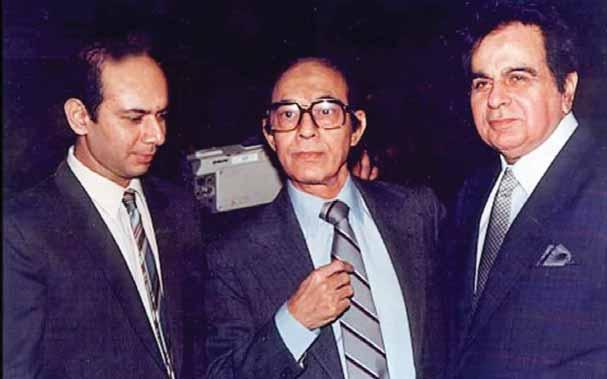

One of his most memorable concert tours was in Trinidad in 1968, where he received a hero’s welcome from thousands of fans waving Talat fan club badges. A music group sang a special Calypso song.
Talat toured the US and Canada seven times between 1969 and 1991 and sang at prestigious venues such as the Madison Square Garden. In 1979, he performed at the renowned Royal Albert Hall, London, with tickets being sold out two weeks in advance.
Over the years, he toured several countries of Asia, Europe and the Middle East. He was awarded the Padma Bhushan in 1992, and also received a slew of awards including the Maharashtra government award and the Lata Mangeshkar puraskar
But perhaps what Talat valued more was the inspiration he provided to top ghazal singers such as Jagjit Singh and Mehdi Hasan.
His relationship with other stars and singers
“He was a perfect gentleman,” Dilip used to say of Talat, who commanded the respect and affection of everyone in Bollywood with his unfailing charm, courtesy and refinement.
Kishore Kumar was one of Talat’s admirers. When Kishore was told at one of his stage shows that Talat was in the audience (his daughter Sabrina was very keen on the show), Kishore announced that the great singer Talat Mahmood was present, and invited him to the stage.
Madan Mohan once hosted a dinner in honour of visiting ghazal queen Begum Akhtar. At the mehfil preceding the dinner, Talat was the
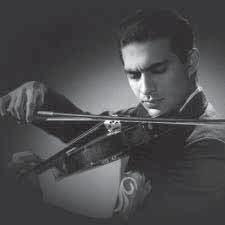
first singer. Kishore, seated between Rafi and Manna Dey, said “Let’s quietly exit, we won’t be able to break the spell cast by Talat.”
Personal preferences
Talat’s favourite foreign singers were Nat King Cole, Pat Boone, Bing Crosby, Elvis Presley and Connie Francis.
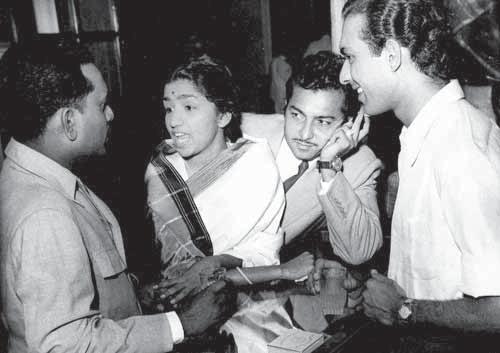
He had a rich collection of the movies of Chaplin and LaurelHardy. A car buff, he enjoyed going on long drives with his family. He loved sweets and no meal was complete without a sweet dish, his favourites being rasagolla, kheer and carrot halwa.
Talat was a heavy smoker for much of his life, and this perhaps told on his health. In his later years, Parkinson’s disease affected his speech. Friends found it heartbreaking that this had happened to one of the world’s best-loved voices. He passed away in 1998 at the age of 74. His global army of fans recall with tears the masterpiece Meri yaad mein tum na ansu bahana.
The author is a senior journalist and a member of the Rotary Club of Madras South
Designed by N Krishnamurthy


















Newsprint is in high demand and the prices have increased steeply. Beginning this year RNT will be spending an additional `50 lakh for the paper alone. As concerned citizens of the world, those of you who are alarmed at the degradation of the environment and slaughter of trees, kindly opt for our e-version.
For every new member the pro-rata is `40 a month.
Please attach the TYPED list of individual members with their complete address, PIN code, Mobile number and e-mail ID. Intimate language preference (English/Hindi/ Tamil) against each member’s name.
Rotary Club of ..........................................................................................................
1. Subscription is for the Rotary year (July to June).
2. It is mandatory for every Rotarian to subscribe to a Rotary magazine.
3. The annual subscription for print version is `480 and e-version is `420 per member.
4. Subscription for the full year must be sent in July in the prescribed form.
5. Those joining after July can pay for the remaining Rotary year at `40 an issue for print version and `35 for e-version.
6. Subscription account of the club with Rotary News is a running account and does not cease at the end of June every year.
7. Names of all members with their complete postal address including PIN CODE, mobile number and e-mail ID must be sent along with the form and DD/cheque payable at par. Online transfers can be made through GPAY or netbanking. When you make an online payment share with us immediately by WhatsApp (9840078074) or email (rotarynews@rosaonline.org) the UTR number, your club name and amount paid. If this is not done your payment will not be updated in our records and your club will show dues outstanding.
8. Language preference (English, Hindi or Tamil) should be stated alongside member’s name.
9. Update the correct mailing address and contact details of your members directly to Rotary News every year to receive the magazine regularly. RI does not share member details with us.
10. Members to ensure their names are included in the subscribers’ list their club sends us. If you’ve paid, but your name is not sent to us by your club, you will not get a copy of the magazine.
11. If you’ve not received your printed copy to which you had subscribed, check with your club president if your club has opted for e-version.
12. Clubs must immediately update us about any deliver the magazine to the new members.
13. Clubs are liable to pay for the number of magazines we despatch according to the list available with the Rotary News Trust.
14. Unpaid dues of the club will be shown as outstanding against the club. Any payment received subsequently will be adjusted against earlier dues.
15. Details of clubs with subscription arrears will be shared with RI and are liable for suspension. Refer the back wrapper (Clubs not subscribing to a Rotary magazine face termination).
16. We regularly verify our subscriber’s list that clubs share with us with that of RI’s data to detect missing subscribers.
17. If a member has not received the magazine for a month, inform us immediately so we can resolve the issue. Magazines are sent through concessional book post; so postal tracking is not possible. You may not receive your copy if your club has not passed on your subscription to us. So please check with your president or RNT for your enrolment in the subscribers’ list.
18. There may be delivery issues in some areas. In such a situation clubs can opt and receive copies in bulk. Additional charges will be applicable.
At the recent COL, an enactment to make magazine subscription voluntary was defeated. Subscription to a Rotary magazine remains mandatory and is not optional. An enactment that all members will receive e-magazine, and can also opt for a printed copy, has also been defeated. Members can opt to subscribe for either e-version or print.

Preeti Mehra
Environment-friendly food choices can go a long way.
Tell me what you eat, and I will tell you what you are,” was the phrase coined in 1826 by French lawyer Anthelme Brillat-Savarin. His words hold good even today in an environmentconscious world where the food we consume is increasingly being seen as a significant factor contributing to carbon emissions.
In fact, it may come as a surprise to many that cultivation of the produce we consume and the agrifood systems that sustain its production, packaging and distribution all determine how environmentfriendly a meal is when it is finally served. These factors did not merit as much attention a decade ago as they do today.
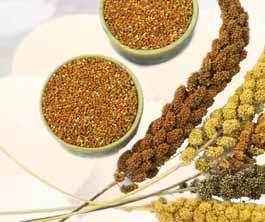
But the times have changed. Now expert opinion is agreed that an important aspect that supports a sustainable lifestyle comes from consciously reducing the carbon footprint of the food we consume. But before we can make any informed and environment-friendly choices, we have to know what creates this footprint in the first place.
The process a particular food has been through before it comes to the supermarket, or the grocery store, is an important contributory factor. Was the product frozen, packaged, processed, pre-cooked, or refrigerated using non-renewable energy?



Was it transported long distances using fossil fuel or shipped by air? Did fertiliser and extensive water use go into its cultivation or was it produced through pesticide-free organic agriculture? All these factors determine a particular food’s share in the carbon pie.
Be it meats, legumes, grains, exotic vegetables, packaged sauces, chutneys and pickles or readyto-eat dishes, preserved spreads, canned beans or tuna and bottled drinks — each comes with a history of its carbon footprint. Some contribute more and some less to the damage.
A few tips culled from research on the subject that will help you make better green choices:
Reduce convenience foods: Working couples often find ready-to-eat packaged food a convenient option on days when a heavy workload in the office leaves little time to cook a fresh meal. But before you yield to the temptation of taking a shortcut, remind yourself that you will not only be reneging on your commitment to be a green citizen but also compromising on your family health. It is widely accepted that packaged heat-and-eat products have reduced nutrients, excess oils, salt and preservatives which are unhealthy. It also leaves a larger carbon footprint than a freshly cooked meal.
But avoiding ready-to-eat food entirely may not always be possible. There will be days when you will be pressed for time to rustle up even a simple meal. In such a situation do opt for the best choice on the supermarket
shelves and complement the packaged meal with green salad, fresh sprouts and home-made yogurt. The important thing to remember in this context is not to allow laziness to overcome you and make heat-and-eat into a habit.
Buy local: Though it is the age of ordering fruits and vegetables online, the better and greener option would be to shop for your daily requirements from the local vendor or the farmers’ market in your area. When you buy food grown or sold locally, it cuts down on the amount of fuel needed to ship the food to your market, and also provides the small producer a livelihood. If organic vegetables are available and can be afforded, that too is a great option.
Eat seasonally: It is now possible in India to buy strawberries in the middle of summer and mangoes in winter. But this weighs rather heavy on your carbon footprint. The so-called ‘fresh’ product may have in all probability been frozen for many months and has consumed large amounts of fossil energy before it reaches the malls. It could have also been sourced from some distant country; blueberry, apple and avocado aften are. A greener option would be eating fruits and vegetables that are seasonal and grown locally. It would not only have a lesser carbon footprint but may also be tastier, fresher and certainly cheaper.
Get the diet mix right: Research says that a diet where 80 per cent food is plantbased is good for both the environment and the body. These days nutritionists recommend healthier
and traditional options like millets and brown rice instead of gluten-rich refined and processed grains. There are several exciting recipes on YouTube which you can experiment with when cooking millets, for instance. Needless to add, any healthy diet would mean limiting the use of sugar and opting for healthier and unrefined sweeteners like jaggery and honey.
Beverage choices: Here again, beverages travel for many miles, are full of sugar and land on your table to add calories and increase your carbon footprint. Water or fresh juices, that too carried around in your own water bottle would be a greener option.
Lastly, and most importantly, when you shop — from your neighbourhood kirana store or online, as many do, go for the less sweetened, less processed, organic choices. The more you can buy in bulk the better. You will, in a small way, be serving the green cause by using less packaging material.
We will be exploring the theme of green cooking next time. Till then, some food for thought.
The writer is a senior journalist who writes on environmental issues


Under its newlycreated avenue,
Able to Ability, RID 3141 organised a series of programmes to mark the International Day of Persons with Disabilities by joining hands with local NGOs and several Rotary clubs in the district. RC Bombay Powai was the lead club. Laughter therapist Bhagwan Babur conducted a workshop on finding happiness, wellbeing and love amid hardships and challenges in daily life. “Around 160 disabled people, parents, caregivers
and Rotarians interacted with the trainer and enjoyed the laughter session,” said Vivek Khandelwal from RC Deonar.
The club donated over 150 ration kits to visuallyimpaired people who enthralled the audience with a musical show hosted by the Human Welfare Charitable Trust.
A panel discussion on mental health challenges and managing disability during the pandemic created the much-needed awareness on the daily hassles being faced by the disabled.


RC Palghar sponsored the wedding of five disabled couples and helped them with household essentials. “The club started a computer training programme for the second batch of 25 hearing and speechimpaired people at the SDSM College, Palghar.”
In another outreach, RC Ghatkopar West donated a specially-designed wheelchair to para athlete Geeta Chouhan for her participation in national and global sports events.
“The day-long event ended with a dual district
Rotarians solemnise the wedding of a disabled couple.
programme with ‘Able to Ability’ of RID 3141 and ‘Enable the Differently Abled’ of RID 3232 coming together on a virtual platform for a common cause,” said Khandelwal. RID 3141 DG Rajendra Agarwal and RID 3232
DGND NS Saravanan attended the virtual meet in which over 100 Rotarians from Chennai, Mumbai and the US interacted with each other.
Four achievers honoured Geeta Chouhan (basketball), Siddharth Sanjay Mhatre (disabled activist), Priya Gada (dancer) and Dhivya K (wheelchair runner) were felicitated for their grit and tenacity to achieve big despite their physical limitations.


Mhatre G their gr achieve physica m ment b consist differen dren br down o filled w program coPrak Cit d
A musical entertainment by Smiling Souls consisting of young differently-abled children brought the curtains down on an eventful day filled with interesting programmes and sessions. Project director AV Suresh from RC Deonar and co-chair M Hari Prakash from RC IT City Chennai coordinated the virtual programme.
Rasheeda Bhagat
If you want to know how Chennai became a centre of excellence in India for diabetes prevention and care, this is the book for you. In ‘Making excellence a habit’, Dr V Mohan an eminent diabetologist in Chennai, tells an absorbing story of how his father, the doyen of diabetology in India, Dr M Viswanathan, deftly but surely, diverted his son’s dream of becoming a great writer, even a poet, to taking up a career in medical science. The schoolboy, who had returned home for his summer holidays in 1968, armed with a stack of English literature classics, was firmly told to divert his interest in writing fiction or poems to creating and publishing research papers in medical science.
Dr Viswanathan was a pioneer in starting the first diabetic clinic in India at the Stanley Medical College where he was working. The clinic evolved into a department of diabetology, and much more recently, was upgraded into an Institute of Diabetology.
But much before that, in the 1960s, when government policies changed, Viswanathan left Stanley and set up his own private diabetes clinic in Royapuram, Chennai, which almost became a Mecca for people from all over India afflicted by diabetes, till the other cities set up, much later, their own diabetes clinics and hospitals.
But not before that institution had got the stamp of world-class research in diabetes, the factors that cause it, its close relationship with lifestyle
Published by Penguin India
Pages: 194
Price : `699
and nutrition, and the grave danger it posed to a diabetic’s health if she did not control her sugar levels.
Dr Mohan, an honorary member of RC Madras East, talks about how his father’s passion for research rubbed off on him, the importance of meticulously maintaining patients’ case studies and the wealth of information these can provide to deepen a doctor’s knowledge about his specialty.
After striking a bit of a romantic note on how the young Mohan wooed and won the heart of his fellow medical student Rema, who went on to become his wife, the author sketches the couple’s journey in branching out from his father’s centre to set up their own diabetes centre in Chennai. As they had a comfortable life in the family venture, “we used to donate most of our earnings to research,” he writes. The two had literally “walked out just with our stethoscopes, and
together, had only about `80,000 in the bank”.
The rest of the book is about the perils of being a medical entrepreneur; the hazards and headache of dealing with landlords and bankers, till one of his patients, the chairman of a top finance company surprised him by offering to fund his entire hospital.
After the first success, more partners and philanthropists came along, including Surya Jhunjhunwala, who donated money to set up a separate research building for his hospital. Later Rema was allotted land at the Women’s Biotech Park in Siruseri, reserved for women entrepreneurs with a scientific background and a 32,000-sqft facility, exclusively for diabetes research, was set up on the 6.5-acre plot allotted to her.
A positive of this book is the author’s simple style, the anecdotes he has packed into it, as also humour, while unravelling some simple truths about handling diabetes.
A useful book on the “secret to building a world-class healthcare system in India”, as the jacket promises.

And it has a testimonial from none less than eminent cardiac surgeon Dr Devi Shetty, who compliments Dr Mohan and his team for elevating the standards of diabetes care in India, and creating a monumental document which will be a guiding force for the future generations of medical students.”
But all of it goes hand-in-hand with the frustration of tall promises when it comes to funding. Entrepreneurship is difficult; medical entrepreneurship much more so, as this book will tell you.

In my last article I wrote about ‘managing stress’. I mentioned ways in which one can manage the symptoms of stress by stimulating the parasympathetic nervous system in the body to calm the body and lower the stressinduced physiological changes such as increased heart rate, breathing and sweaty palms. The modalities I mentioned (breathing, exercise, meditation, mindfulness) are necessary and useful to remain calm. In this article let’s see how we can leverage stress, not just manage it.
Traditionally we have been influenced to view stress and stressful events as being debilitating. It is often believed that stress is bad for our health, relationships, work, cognition and longevity. However this need not be true. Experiencing some amount of stress during our journey to achieve our goals can actually help us focus better and progress faster.
How our body responds to stress and the aftermath appears to hinge on this deep-rooted belief system called the mindset. What exactly is a mindset? Mindset is the default setting of the mind with regard to broad topics and subjects such as health, diet, stress, exercise, politics, etc. It is the overall perspective we have about such subjects which governs the way we perceive a topic, the decisions we make around it and even how our body responds to the decisions we make. For instance, if we have a mindset about exercise that it is painful and boring, we are most likely to not enjoy it, or even benefit adequately from it. If we have a mindset about food that ‘healthy food’ is tasteless and boring, we are less likely to persist with a healthy diet or feel satisfied with it. Mindsets are usually programmed into us from our early years. They get internalised from the messages we receive
from around us. This is not always a conscious thing. Very often we don’t really know what our mindset about something is unless we actually think about it and ask ourselves the question. We often make choices not realising that they are based on our already pre-determined mindset. The concept of post-traumatic growth is the ability of the body to improve instead of disintegrating even after the most traumatising stressful event. Such events can help us realise our meaning and purpose in life. Something we may never have addressed otherwise. They can bring us closer to people who matter to us, help us identify what we really value in life and focus on that. It can trigger a passion for life, create more joy and help us develop a sense of gratitude.
For instance, talking to people through this pandemic I have found much of this happening. While the

pandemic in itself has been stressful for everyone, it has caused many people to re-think about values, relationships, their health, their work and what exactly it means to them. People have become more serious about improving health. Some have quit jobs that they found more detrimental than beneficial. Some have
If you view a difficult relationship as a challenge rather than something that debilitates you, you are more likely to deal with it appropriately and not be destroyed by it.
started spending more time nurturing their relationships and valuing them. Sometimes a stressful event helps us think differently about everything. Research from Stanford University has revealed that the ability to handle stress and even grow from it depends on the way we view stress and what we believe about it. For instance, if we believe that stress is essentially debilitating then our ability to recover from the stressor is limited. But if we believe that stress is empowering and can even aid in growth, our ability to recover from it and even grow from it is enhanced. Our mindset about stress has the capacity to influence how our body and mind respond to stress, especially in the long term. When you view the ‘stressor’ as a challenge rather than a threat, you are more likely to respond more positively and be adaptive to the event. For instance, if you view your interview/ exam/work as a challenge you are more likely to approach it with an open mind and do better than if you view it as a threat and feel anxious or overwhelmed. If you view a difficult relationship as a challenge rather than something that debilitates you, you are more likely to deal with it appropriately and not be destroyed by it. If you see stress as a natural phenomenon that is ubiquitous and unavoidable, but also something that can be life-enhancing, you are more likely to be positively influenced by it and grow from it. By altering our mindset we can leverage stress to our benefit.
There are numerous real-life stories of people who have overcome the most horrendous experiences and not just live to survive but to thrive. One such example is the life of Dr Viktor Frankl, an Austrian neurologist, psychiatrist and a holocaust survivor. His book, ‘A man’s search for
meaning’ is worth reading. Dr Frankl says that man’s deepest desire is to search for meaning and purpose in life. His mindset about his circumstances (horrific as they were), and the stress thereof, enabled him to not just survive the concentration camps, but helped him thrive after getting out by helping millions of people with his work.
Researchers Dr Crum and colleagues found that when participants of a research study were exposed to positive images of stress that suggested that stress was a positive thing that helps you grow, they actually did better, had better physical and mental health, better performance at work, less aches and pains and less anxiety. People who were exposed to the usual images of stress as being debilitating did not do better when exposed to it. This research showed the effect of even brief exposures to attitudes towards stress (as being enhancing or debilitating) can drastically change how one reacts to any kind of stress.
Rethinking stress and how it can affect us depending on how we view it can be a gamechanger. Considering that we are going to experience stress in varying degrees through our lives, having a more positive and empowering mindset can only benefit us.
Following a stressful event, some questions to ask yourself:
What can I learn from this experience; how can I reset my priorities; how can I improve and renegotiate my relationships, values, expectations and goals.
And, how can I benefit or be grateful for from this experience?
The author is a lifestyle medicine physician. sheela.nambiar@gmail.com www.drsheelanambiar.com



HOUSTON, TEXAS, USA 4-8 JUNE 2022
Register today at convention.rotary.org




Rotary at a glance

Rotary clubs : 36,945
Rotaract clubs :11,150
Interact clubs :16,872
RCCs :12,082
Rotary members: 1,204,997
Rotaract members:234,520
Interact members:398,475
As on April 20, 2022 AT
64,062 1,313,747 48,261 1,971,864 533,479 369,602 125,682 211,042 58,464 73,170 604,379 479,535 370,224 34,593 56,419 79,763 48,667




of 3,000 volunteers that led to ‘a comprehensive documentation of all living Indian languages in 50 volumes’ called the People’s Linguistic Survey of India. He works extensively with denotified and nomadic tribes, is the founder of the Bhasha Research and Publication Centre in Baroda, and the Adivasi Academy in Tejgadh, and writes in Marathi, Gujarati and English on subjects such as literary criticism, anthropology, education, linguistics and philosophy. He was among those who returned their Sahitya Akademi Award in protest against the threat to freedom of expression and growing intolerance.
immense diversity of every kind. The Mahabharata unites us not in any imagined territorial national space; it brings us together in Time, symbolised by the never-stopping kala-chakra, the epic’s iconic symbol, which teaches us a great spirit of acceptance of all that is in complete humility.’

Sandhya Rao

Revisiting two enduring narratives reinforces the belief that riches of the heart and mind result from a free and fair play of diversity.
When the centre cannot hold, as WB Yeats warned in ‘The Second Coming’, things fall apart, and ‘mere anarchy is loosed upon the world’. This is where we seem to be today. Where do we go from here is the tormenting question. While drowning in despondency, I chanced upon Mahabharata: The Epic and the Nation by GN Devy and my interest was piqued.
For another, the timeless magic of the Mahabharata. As Devy observes, ‘It may not be quite off the mark to say that, among other cultural elements, the Mahabharata is one significant cultural production that brings Indians together. The diversity of language, land and life patterns in this country is so vast that no Indian can genuinely relate to all of it. Probably, it is through cultural practices and icons like the Mahabharata that we have a sense of being united.’

For one, Devy. After a teaching career, he headed a major linguistic survey with the help
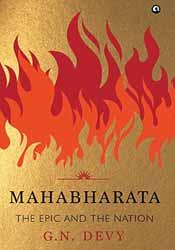
Devy argues that the epic has created a unique method of remembering the past, a method he says India has internalised, as ‘the way of preserving its national memory’. Then he goes on to make a significant statement: ‘The Mahabharata spirit is bound to agitate against any jingoistic and unitary sense of the subcontinent as a nation, for it is marked by an
What about the Ramayana, then, the other timeless epic? That too has recently found expression in a unique book: no, not an interpretation but an engaging piece of travel writing. It all began with an innocuous question Vikrant Pande and Neelesh Kulkarni asked friends about where Chitrakoot was. Nobody knew, nor could they locate Kishkindha, although the names were familiar. So the two decided they would find out for themselves and started on a journey across India and Sri Lanka to all the places mentioned in the epic. This gave birth to In the Footsteps of Rama: Travels with the Ramayana. And before you pass judgement, it’s not a ‘religious’ work, it really is about travel, stories, and versions of stories, and the ‘willing suspension of disbelief’, to quote Coleridge. Their journey begins and ends at Hanuman Garhi in Ayodhya, where Hanuman is said to have ‘settled down’. The mahant of this temple, Baba Gyan Das, asks: ‘Do you know who built this fort? It was a Muslim ruler. Not only did he build the fort, he also granted the temple freedom from all taxes and decreed


that no one could litigate against it ever.’ According to him, the son of Abdul Mansoor Khan Safdarjang, the second Nawab of Oudh, was cured of leprosy by the power of Hanuman. In grateful thanks, Mansoor Khan built a fort to house the temple.

he perfected the Sanjeevani drug that resurrected dead rakshasas.’
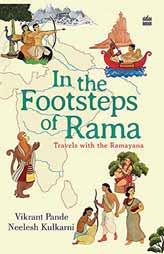


Each place they visit all the way down to Sri Lanka and back evokes several stories, often at variance with what they had read while researching the Ramayana prior to undertaking this journey. They meet interesting people, take in different landscapes and, yes, taste delicious food — or not! For instance, on the edge of Allahabad fort is where Sita is believed to have prayed before leaving for Chitrakoot; but before leaving Allahabad, our authors make sure to taste Bhagat Chaat Bhandar’s mouthwatering pakore ki chaat! From Delhi they take the Sampark Kranti Express to Chitrakoot where they were advised to stay because the forest had ‘plenty of animals to hunt, many trees that bear fruit, and where many ascetics have chosen to live.’
They come across a village en route to Nashik where, apparently, Sita was abandoned after aspersions were cast on her character. However, when the villagers ignored her pleas for help, she cursed them saying wheat would never grow in their soil.
‘The curse stayed for thousands of years, all the way till 1965, when the Green Revolution brought in a hybrid variety of wheat and other grains that could be grown here,’ a village elder tells the authors. ‘… grain stalks would simply crumble if we tried sowing wheat here…’
While they found some places difficult to locate, some seemed even to have been forgotten. But the majority were well remembered, both by the people and through folklore. At times, though, it seemed the stories were very much imagined, as in Mumbai, for instance. But, as a trustee of a temple in Walkeshwar tells them, ‘It is not about what happened here, but what people believe in.’ This
remark makes the authors realise that ‘the truth is only what we want to believe. If people believe Rama came to Mumbai, then he sure did!’
Apparently, the popular stories about the Lakshman Rekha and Shabari tasting every berry she offered Rama has no literary or historical validity in any of the five versions of the epic — Tulsidas, Valmiki, Eknath, Kambar and Adhyathmak — the authors researched. A mismatch between distances mentioned in the epic and facts suggest that Lanka was possibly larger than the Sri Lanka of today. It is such an irony that a kingdom described as being rich and prosperous is now facing its biggest economic crisis.


Pande and Kulkarni embark on a 450-foot descent through thick forest to Lonar lake in Maharashtra; the lake is in the middle of a crater which ‘is one of the only four impact craters in the world in basaltic rock and is still beautifully preserved. Maskelynite, a glasslike material that was thrown up by the impact, still shines through the sand at the edges of the lake.’ Locals believe the lake was ‘Shukracharya’s laboratory where
The world is full of Ramas and Ravanas, individuals of great merit, yet vulnerable to human frailties. But one thread runs through both epics, and that is the self-destructive nature of hate.
‘We notice that most temples in Sri Lanka also house prominent Buddhist pilgrimage sites,’ the authors note. ‘The Murugan temple in Kataragama is more well-known for the Buddhist complex inside (it also houses a mosque, a church, a temple to a tribal deity, and a temple to Ganesha), apart from those dedicated to Murugan’s wives — Valli and Devayani.’ And at Nil Diya Pokuna, or blue water lake, they trudge through a pitch-dark tunnel in Istripuram to see the cave where Sita was supposedly hidden, but they don’t have the stomach to squeeze into the cave. ‘Many believe that Ravana still lives in these caves,’ their guide tells them as they beat a hasty retreat!

The world is full of Ramas and Ravanas, individuals of great merit, yet vulnerable to human frailties. But one thread runs through both epics, and that is the self-destructive nature of hate. Now, that’s a lesson for our time.

The columnist is a children’s writer and senior journalist
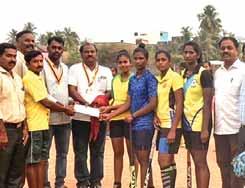
The club, along with RC Pondicherry Marina, sponsored travel expenses worth `22,000 for 21 players to attend the Junior Women’s Hockey National Championship at Kakinada, Andhra Pradesh.

SCAW (Sleeping Children Around the World) kits were given by the club to 66 students studying in the government middle schools.
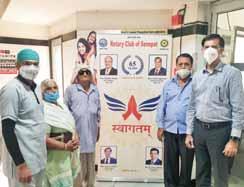
Under Project Vision 50, cataract surgeries were done on 35 patients. The club hopes to sponsor the treatment for 50 patients by this year-end.
Blankets were distributed to homeless families in and around Visakhapatnam, including some tribal areas.
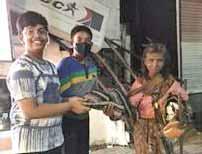
Under Project Dose, Diet and Drills, the club, in association with the AIIMS, Nagpur, provides medicines for a year for four diabetic children.

A Phacoemulsification unit was installed at the Pali Sewa Mandal Eye Hospital through a GG project worth `11 lakh for eye surgeries. RC Charlotte Hall, RID 7620, is the partner.

RC Surat Roundtown — RID 3060RC Lucknow Rajdhani — RID 3120

A Rotary Run for 10km to mark the golden jubilee year of the club was flagged off by police commissioner Ajay Tomar in the presence of DG Santosh Pradhan.
Around 1,000 people participated.

DG Samar Raj Garg and police commissioner D K Thakur flagged off a women’s car rally. A treasure hunt was organised with the support of an English daily.
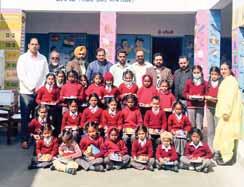
Stationery items were distributed to students at a government girls’ school in Phagwara as part of its regular monthly project across the city schools.
Grocery kits were distributed to around 500 tribals at Andgaon village near Pune. Many of the beneficiaries have lost their source of income due to Covid.

Aligarh Mansi — RID 3110RI District 3141
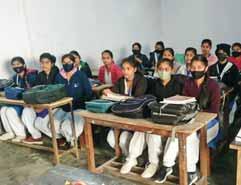
A series of cervical cancer awareness talks was held at schools in which 1,000 girls took part. Club president Dr Neeti Goyal and DG Mukesh Singhal were present.
Tablets were given to teachers at the Mumbai Corporation schools in the presence of mayor Kishoritai Pednekar. Sewing machines were given to 500 women.
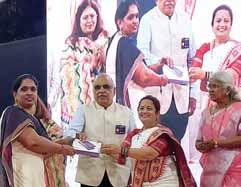
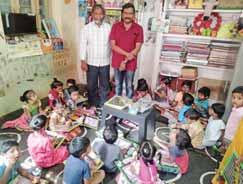
Slates, books and sweets were given to children at an anganwadi school in Guntur.
A computer system worth `43,000 was donated to the Bharath Scouts, Mangalore, for their office use.
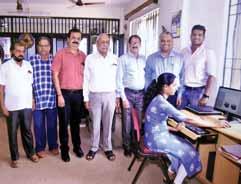
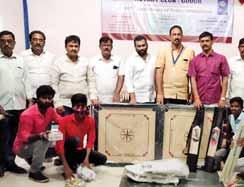
Scholarships, sports kits, lab equipment and water cooler were donated to schools as part of Rotary Day celebrations. An auditorium at the SKR Government Degree College was renovated.
Thirty-five women from different walks of life were honoured at an event to mark Women’s Day.


The club members painted a classroom, benches, meditation hall and computer lab under Happy School project. Book racks were also installed.
Seventy amputees were fitted with artificial limbs worth `3 lakh at a joint project with RCs Coimbatore Midtown and Melawati, Malaysia, RID 3300.
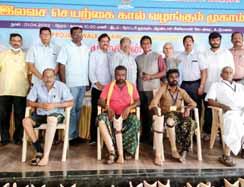

DG Dr Rajesh Subash handed over a defibrillator worth `3 lakh to Dr Santhosh, MD, at the Calicut Medical College for the Government Institute of Chest Diseases.
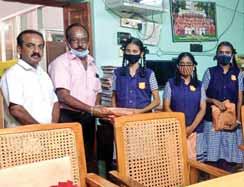
Under Project 30, the club selected 30 members to donate either in cash or kind worth `1,000 daily to underprivileged students, families or differently-abled for a year.
Project Mellinam screened 1,000 women for breast cancer in less than four weeks of its launch. The club tied up with four nursing colleges and an NGO for holding camps.

Around 30 mentallychallenged children were examined at the Divyang camp at the Holy Family Hospital, Koderma. Dr Anil Kumar Pandey diagnosed them. Medicines were given.
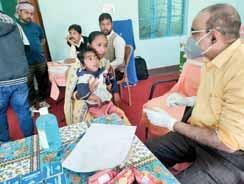

A shelter at the Aruppumedu Government Middle School, Katpadi, was renovated by the club.
A WinS project was done at a government school with the efforts of club president Rashmi Ranjan Mahapatra and secretary Alekhika Pani.
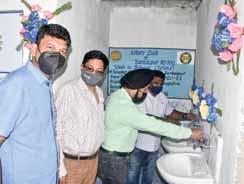
Compiled by V Muthukumaran
All of last month, having always been an early riser, I spent the mornings watching the ICC Women’s World Cup in cricket. It was an absolute revelation. The women displayed wonderful skills. Gone are the days when their game looked weak and anaemic. These women, many barely out of their teens, played like any men’s team would. They batted with excellent technique. They bowled exactly the way they should. If they played below par, it was in fielding. But they understood the need of the moment and made required changes. Believe me, it was a real pleasure. In the end as was expected the Australians beat England in the final, which India should have played.The Indian women lost by a sheer quirk of fate. South Africa won off the last ball because an extra ball had to be bowled after a wide, and entered the semifinal in a thriller match.
There were some fabulous offfield moments too. We saw the Indians playing with the Pakistani captain’s two-month-old baby. India had just won that match. No one who saw that would have failed to get emotional. It was so great to see the joy on their faces. Hopefully, India will win the cup next time. Its team is good enough to beat any opponent.
Now there’s going to be a women’s IPL T20 tournament as well.
In March this year the BCCI announced that a franchise-based annual T20 tournament for women will start next year with six teams. I can’t wait for it.
My motto is let there be more and more cricket. The more cricket there is, the less dreary life becomes. It may have begun in England which makes a virtue of dreariness but the rest of the cricket playing countries have energised it to a degree that matches international football. Millions watch and forget their travails for a little while.
Many people can’t understand why. The reason is that cricket is totally a game of chance. From the moment the ball leaves the bowler’s hand till it becomes a ‘dead ball’ you don’t know what’s going to happen. There are literally an infinite number of possibilities. Just think about it

and you will understand what I am saying.
Look at what can happen. 6, 4, 3, 2, 1, 0 runs. Out. Not out. Bowled. Caught. Run out. Stumped. Lbw. Short run. Collision. Catch dropped. Six prevented at the boundary. No other game allows so many possible outcomes from a single ball. And if it’s a Test match there are a maximum of 2,700 balls to be bowled in case the match doesn’t finish before that. In a 50-over match the maximum is 600 balls. And in a 20-over game, the maximum is 240. If in each ball there are at least a dozen possibilities, you see how full of chance the game is. Anything can happen, including, very tragically, once even the death of a batsman. Which other game has that possibility?
Cricket is totally a game of chance. From the moment the ball leaves the bowler’s hand till it becomes a ‘dead ball’ there can be an infinite number of possibilities.
What puzzles me is why just about 15 countries play cricket properly. Even there, many teams are made up of players from South Asia. I remember back in 1995 the European Commission sent out a team to India to find out why so few Indians were aware of the European Union and why everyone here thought only of individual countries there. They invited some journalists for lunch and asked their questions. My answer was simple: start playing cricket. Foolishly they ignored my advice and guess what happened? The only country in the EU that plays cricket left it.

An Airbus A380, the largest passenger jet in the world, completed a threehour intra-French test flight on Sustainable Aviation Fuel (SAF) — typically derived from cooking oil or other waste fats. Previously, the Airbus flew its A319 neo single-aisle aircraft in October 2021using SAF.

In a big step forward in understanding cell reprogramming, scientists at the Babraham Institute have developed a method to turn back the human cellular aging clock by 30 years without losing its specialised cellular function. The method of regenerating skin is based on the Nobel Prize winning technique scientists used to make stem cells to see how DNA defects in kids cause cancer.


A café with an all-HIV positive staff Exclusively run by HIV positive staff, Cafe Positive
in Kolkata aims to spread awareness and generate employment for HIV positive people. The staff includes seven HIV positive teenagers. Kallol Ghosh, the owner of the cafe and founder of Anandaghar, an NGO which works with children affected by AIDS, was inspired by a cafe in Frankfurt, run by HIV positive people.

A Maldivian scientist has discovered a new species of rainbow-coloured fish at depths ranging from 131 to 229 feet in the Indian Ocean, off the coast of the Maldives. It has been named Cirrhilabrus finifenmaa inspired by the pink rose, the national flower of the Maldives.
Sam Bankman-Fried, a 30-year-old cryptocurrency billionaire, with a fortune of more than $20 billion plans to donate it all to good causes. Bankman, after keeping enough money to maintain a comfortable lifestyle ($100,000 a year), will contribute to the causes close to his heart, starting with pandemic preparedness. He has already given $5 million to a non-profit investigative journalism group.
Compiled by Kiran Zehra; Designed by Krishnapratheesh
Registered No. TN/CCN/360/2021-2023
Licensed to post WPP No.TN/PMG(CCR)/WPP 431/21-23
Total number of pages in this monthly issue, including cover, 84. Price: `35
Registered with Registrar of News Papers for India 3880/57 Rotary News Published on the first week of every month
For several years, Rotary clubs not subscribing to a Rotary magazine or not paying magazine dues have frustrated the regional magazine managers. Non-subscription has a direct impact on sharing Rotary’s core messages.
After the RI Communications Committee’s deliberations on non-compliant clubs, at its November Board meet, RI has updated its rules for non-compliant clubs, which could now face termination. Existing rules and new ones:
Previous Process
The magazine office sends a report of non-compliant clubs to Rotary International.
Template letters from the district secretariat are shared with the magazine office, which then sends the letter to the appropriate clubs.






New Process beginning July 1, 2022
The magazine sends a report of non-compliant clubs to RI, clarifying if they are non-compliant due to non-payment - OR - not subscribing at all. Reports should be sent quarterly.
The magazine sends the letter to the clubs; Rotary will notify the District Governor with a separate letter.
The club has 120 days to comply or be suspended.The club has 90 days to comply or be suspended. If the club does not comply, the magazine sends a report to RI. Clubs are suspended.
Two weeks before the 90-day grace period, another reminder is sent to clubs still non-compliant. If the club does not comply, the magazine sends a report to RI. Clubs are suspended.
Process ended here.
For clubs that stay suspended and non-compliant for 180 days, another letter is to be sent stating “the Board at its discretion can terminate the club.”
Monitor club.
PETS & GETS curriculums will include information about mandatory subscriptions.
A threshold defining non-compliance will be determined: either 20% or 50% of club members?
Since this process will now be included in the Rotary Code of Policies, we hope to see better compliance. The Board of Directors to advocate for magazines in their zones. Directors were surprised to learn of the non-compliance of clubs, and that there are district governors and club presidents who are not aware of the mandatory subscription. That means Rotary must increase the messaging on mandatory subscriptions at PETS and GETS.
(For the information of our readers, the German regional magazine is delivered to over 65,000 Rotarians — almost 99 per cent of the total number. The rest subscribe to Rotary. In Japan, of the 85,000 members, 99 per cent subscribe to RotaryNo-Tomo; the remaining one per cent and many other Rotarians, subscribe to Rotary. In Switzerland and Liechtenstein — with 13,200 Rotarians in total — there’s only one club that doesn’t want to subscribe to any Rotary magazine. The local DGs are now solving that problem.)
Rotary News urges Rotary clubs in our zones to pay their subscription dues diligently. Message from Rotary International